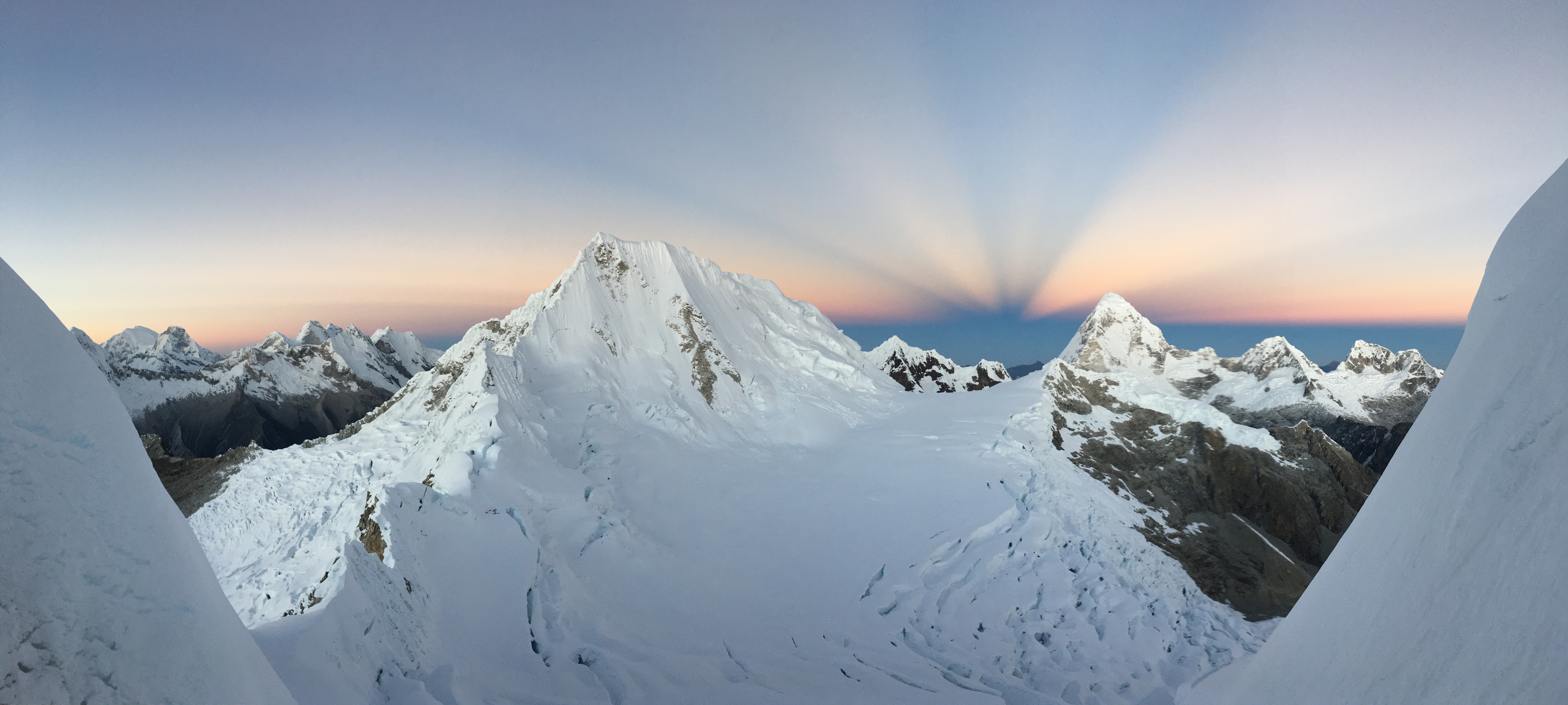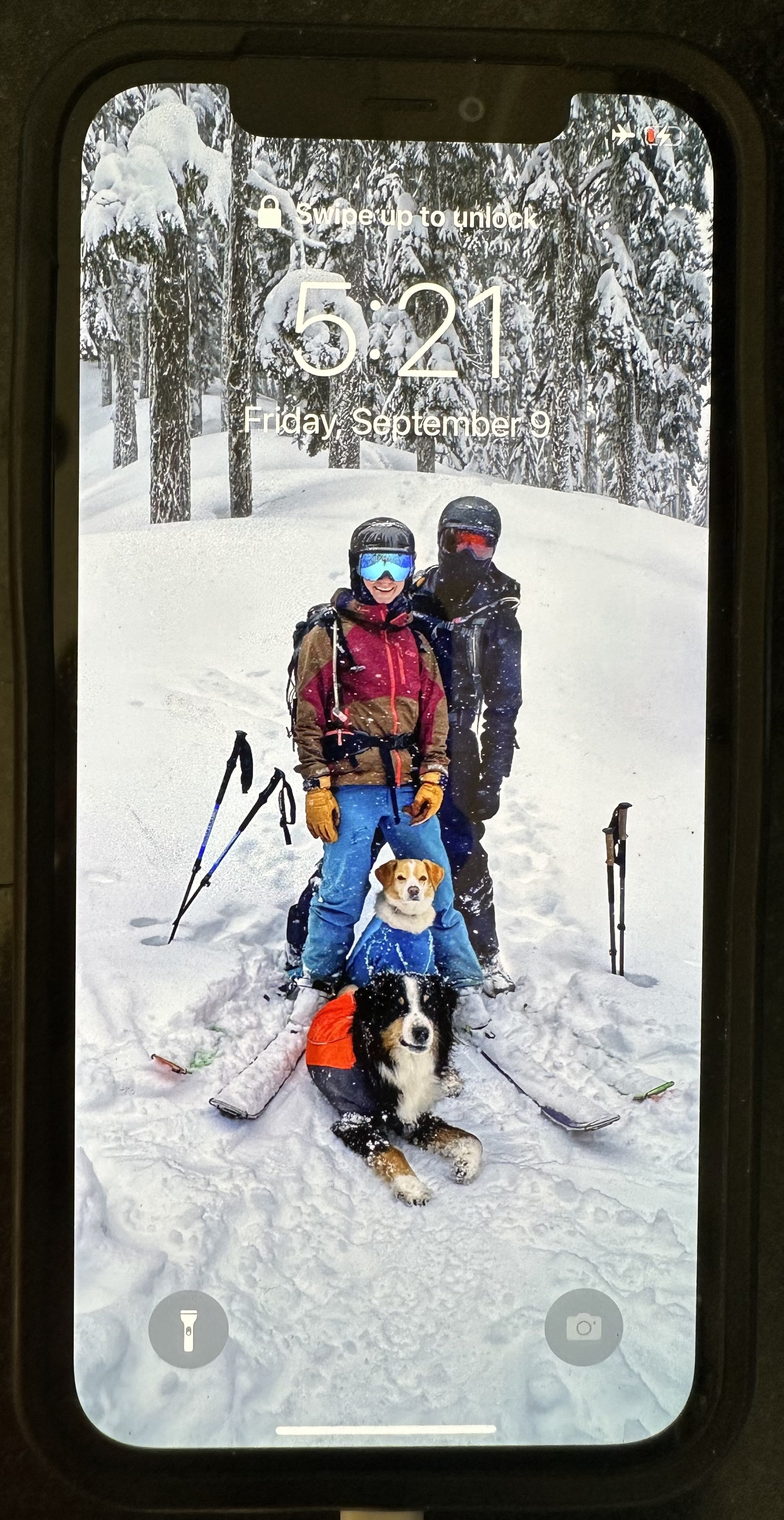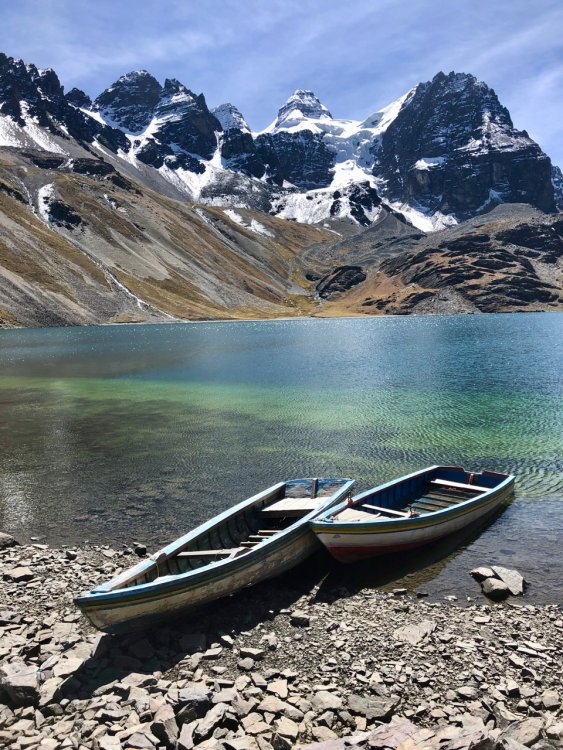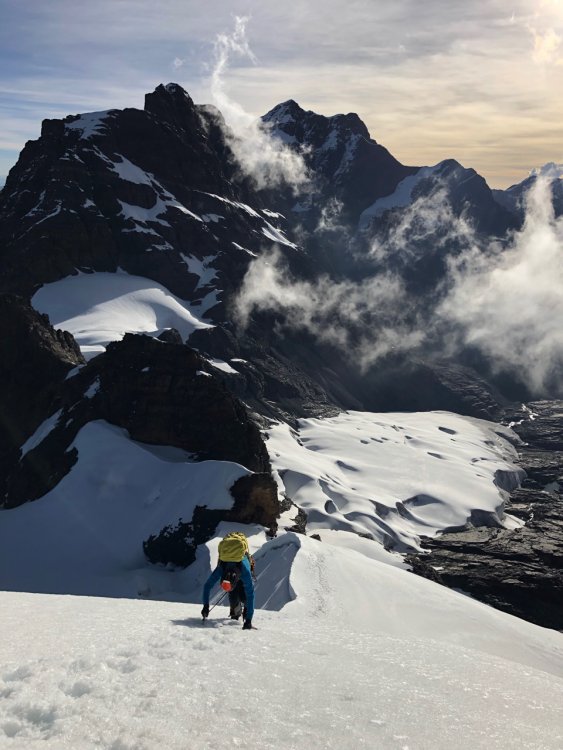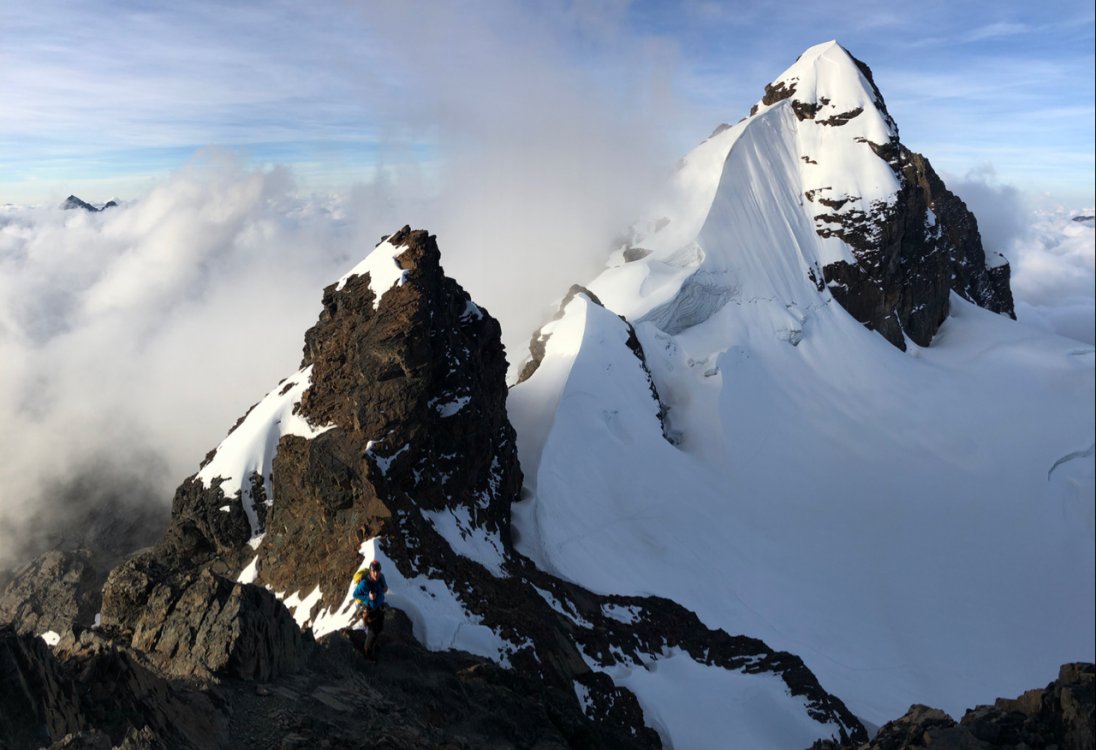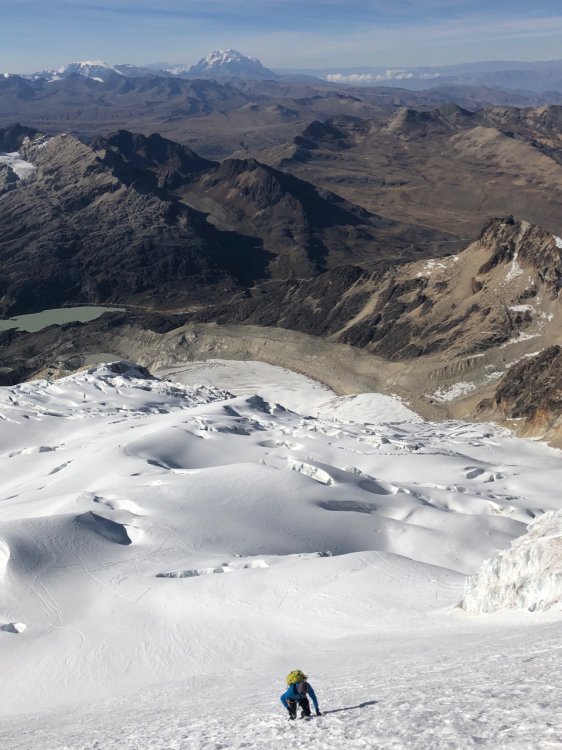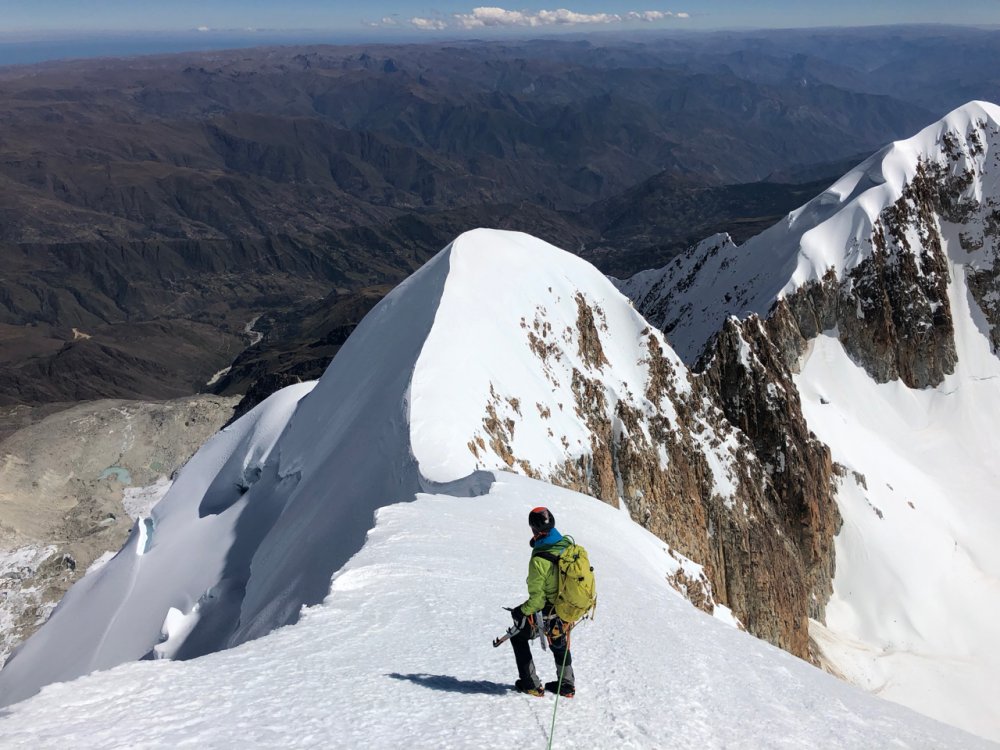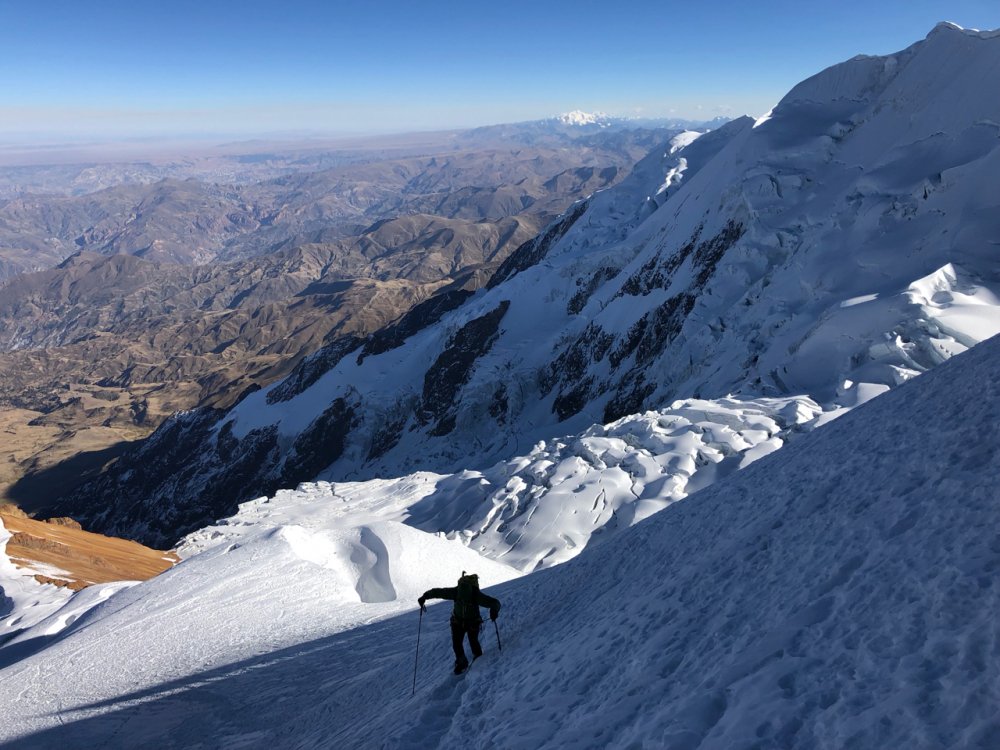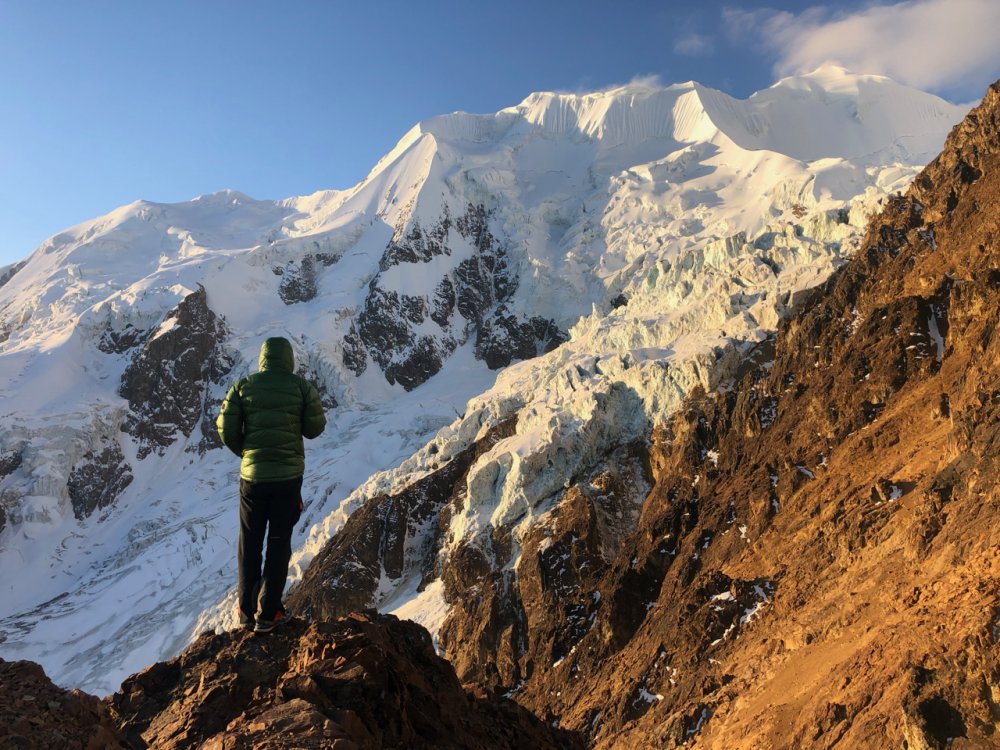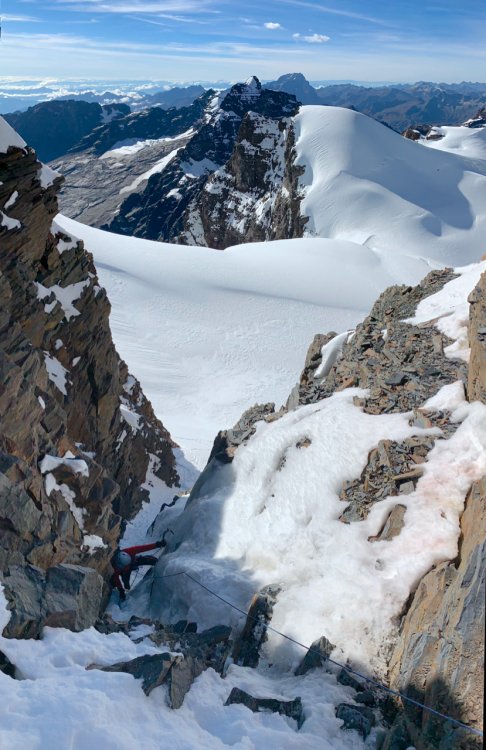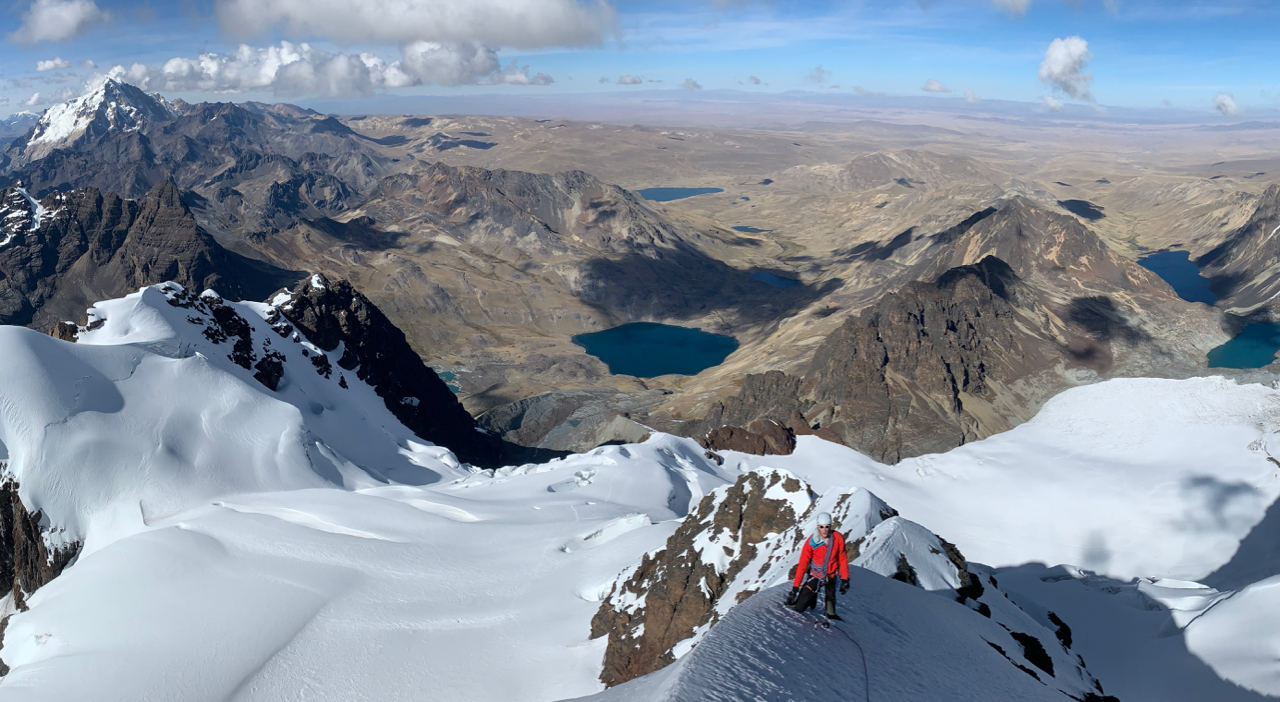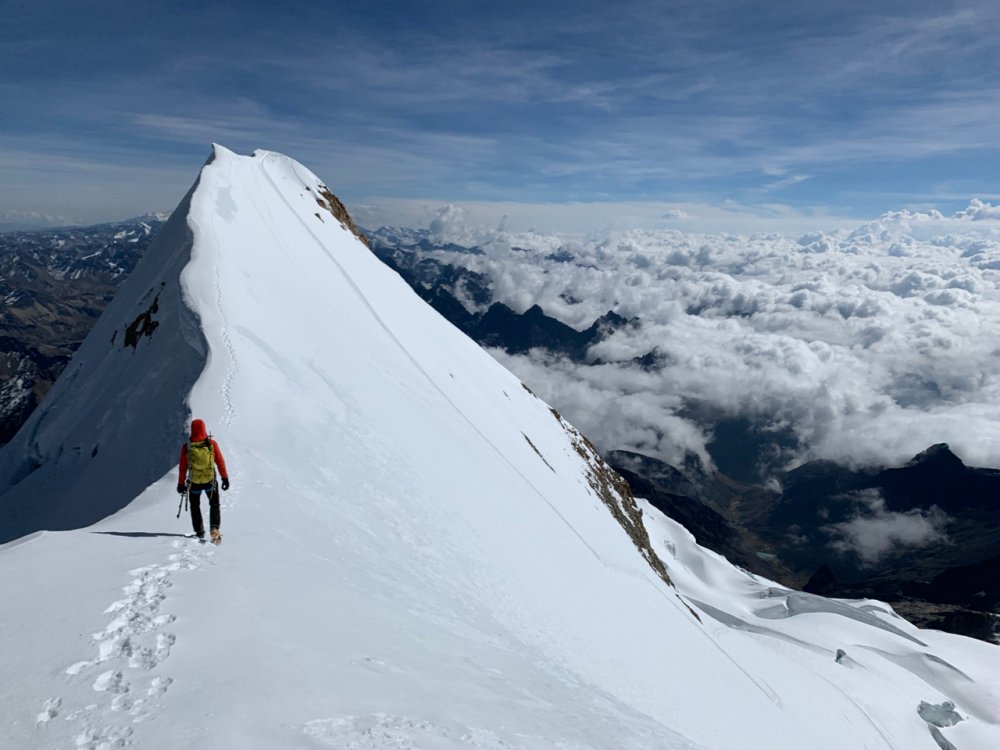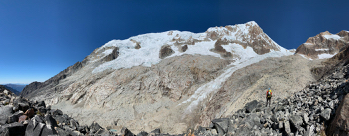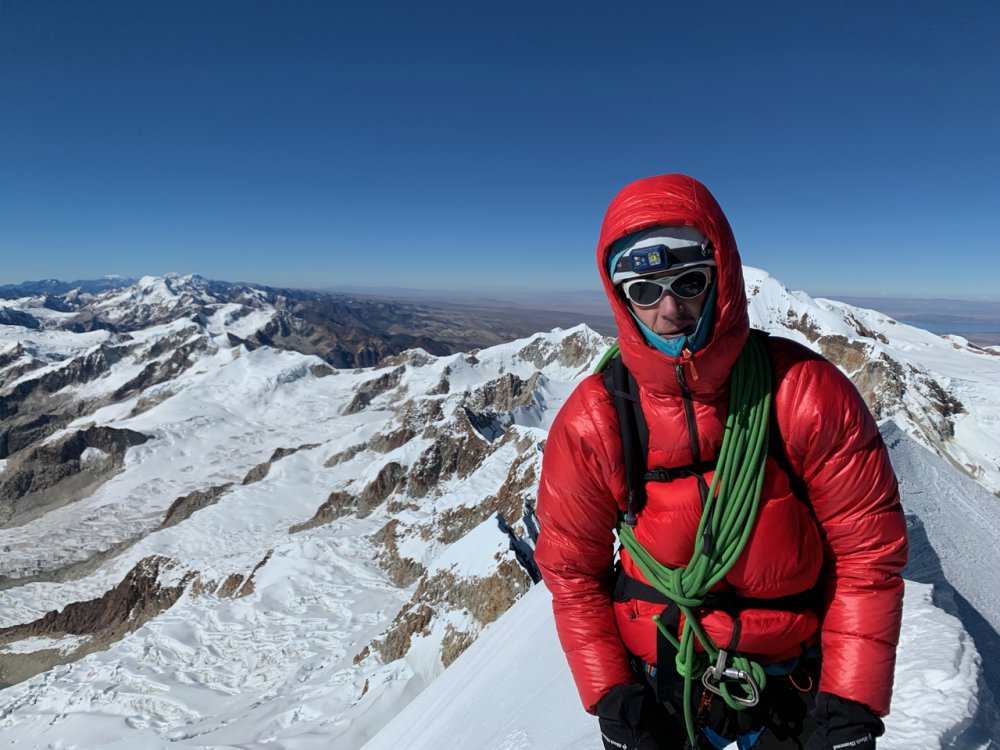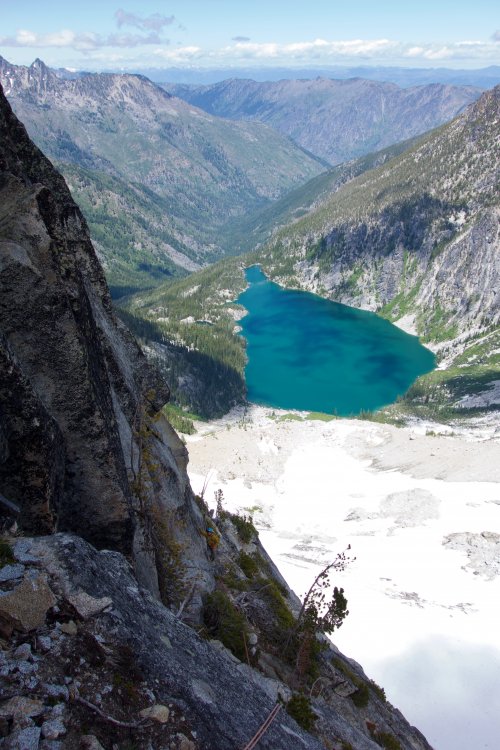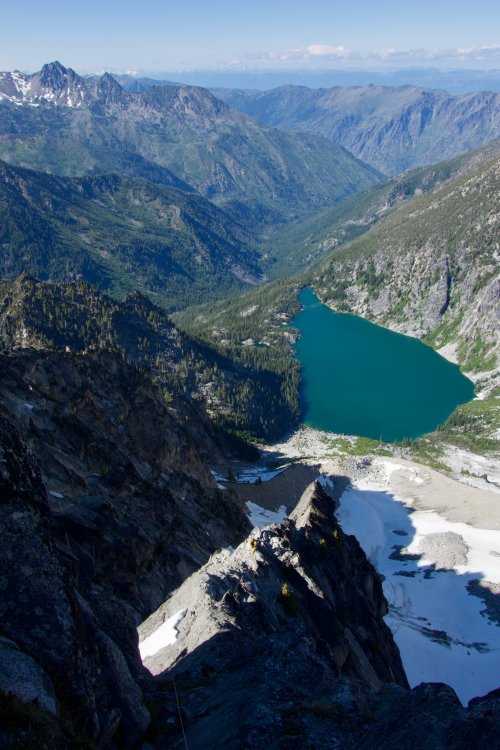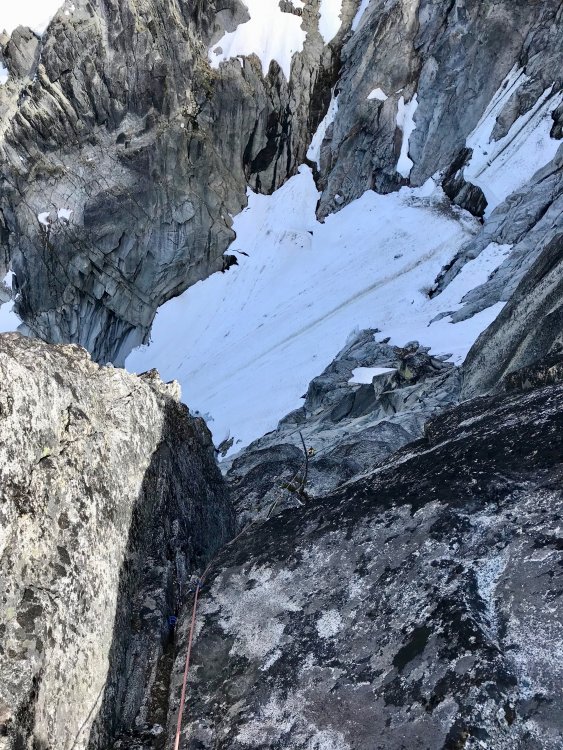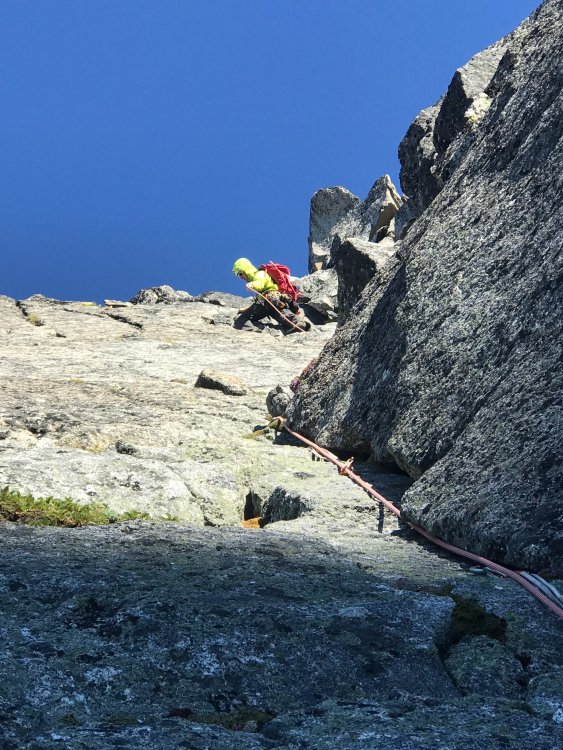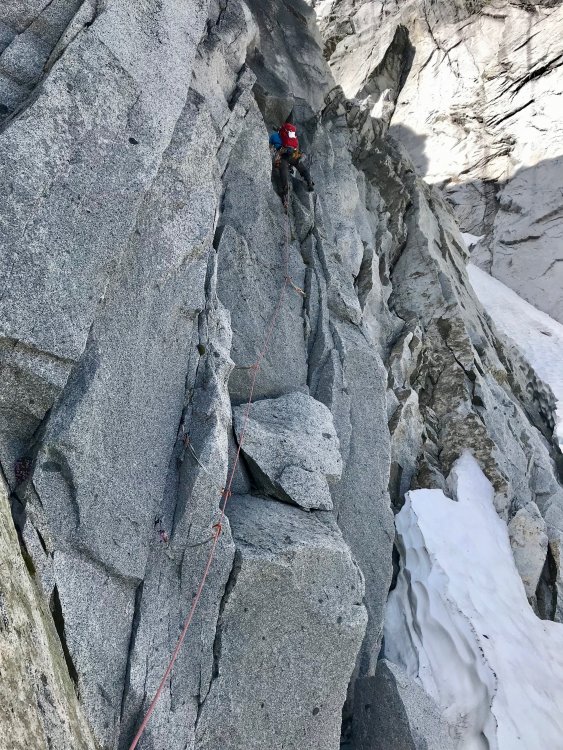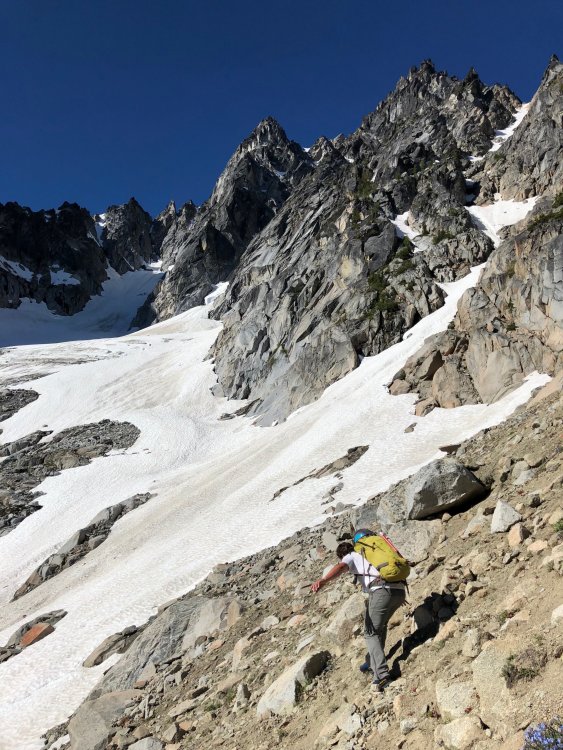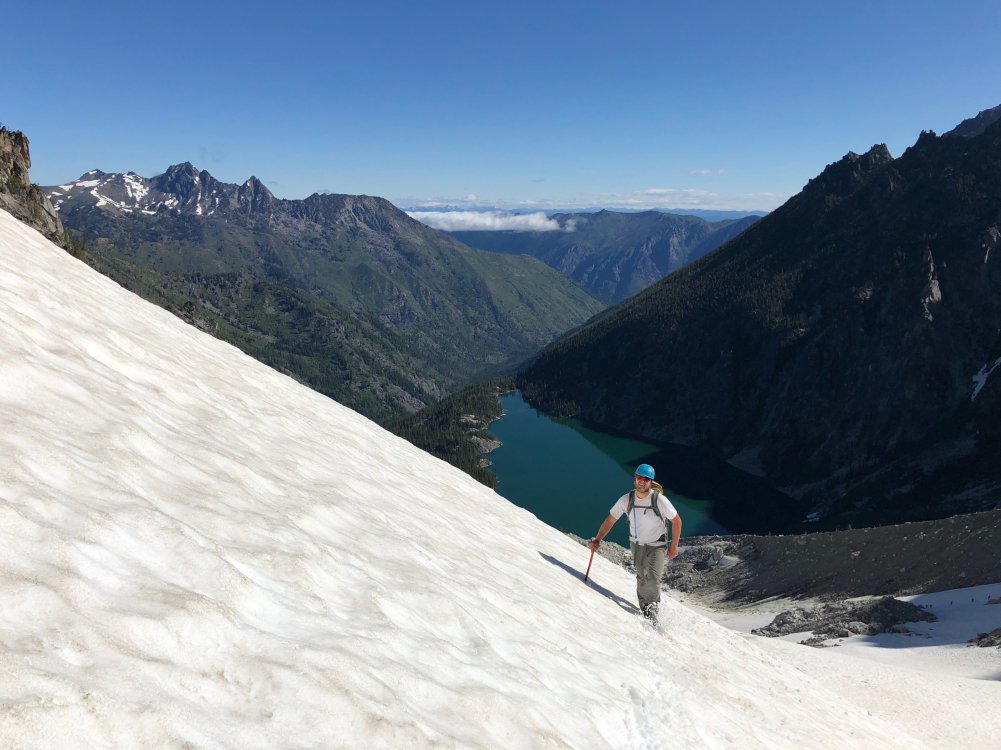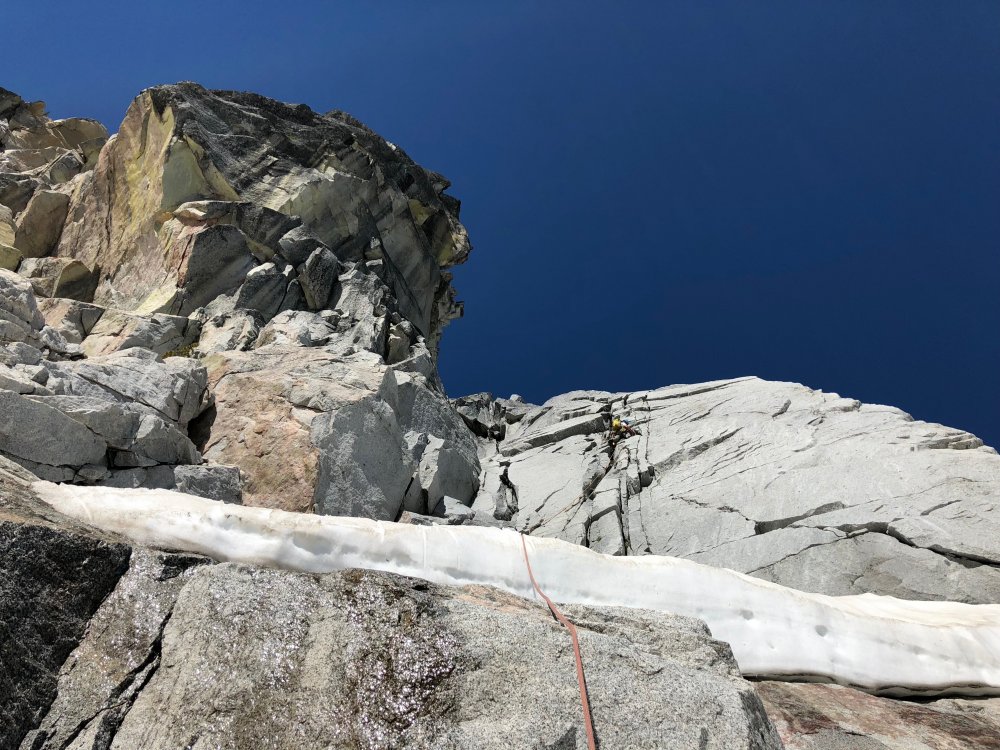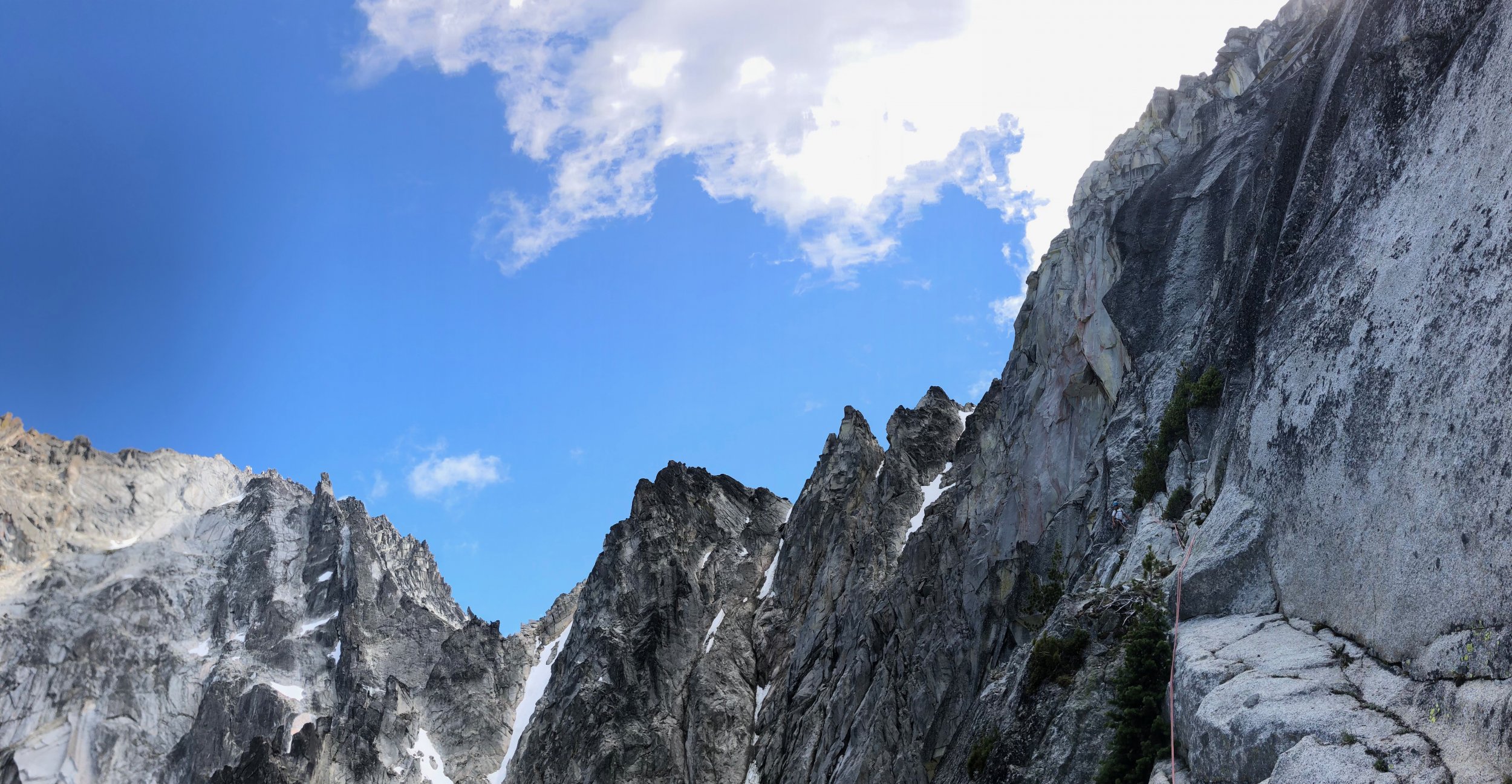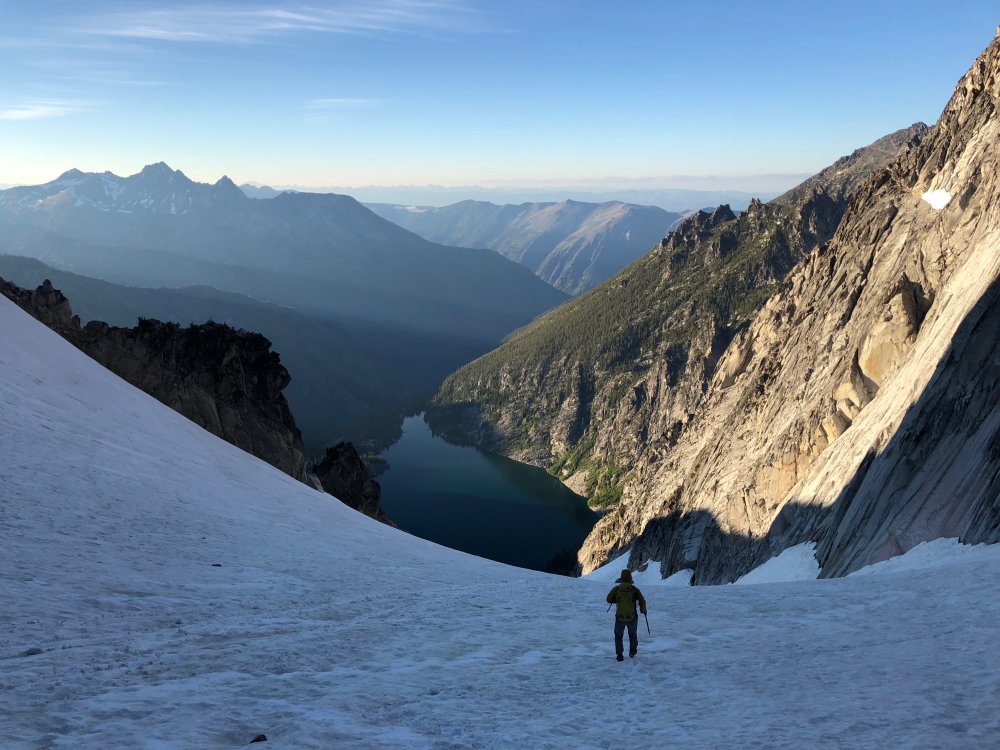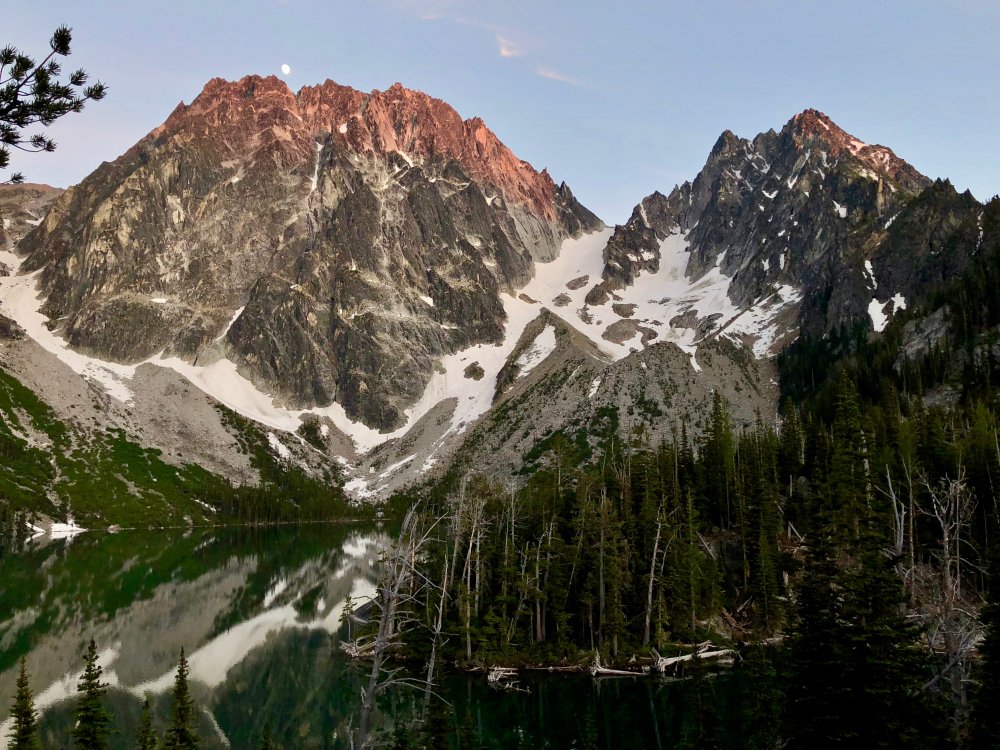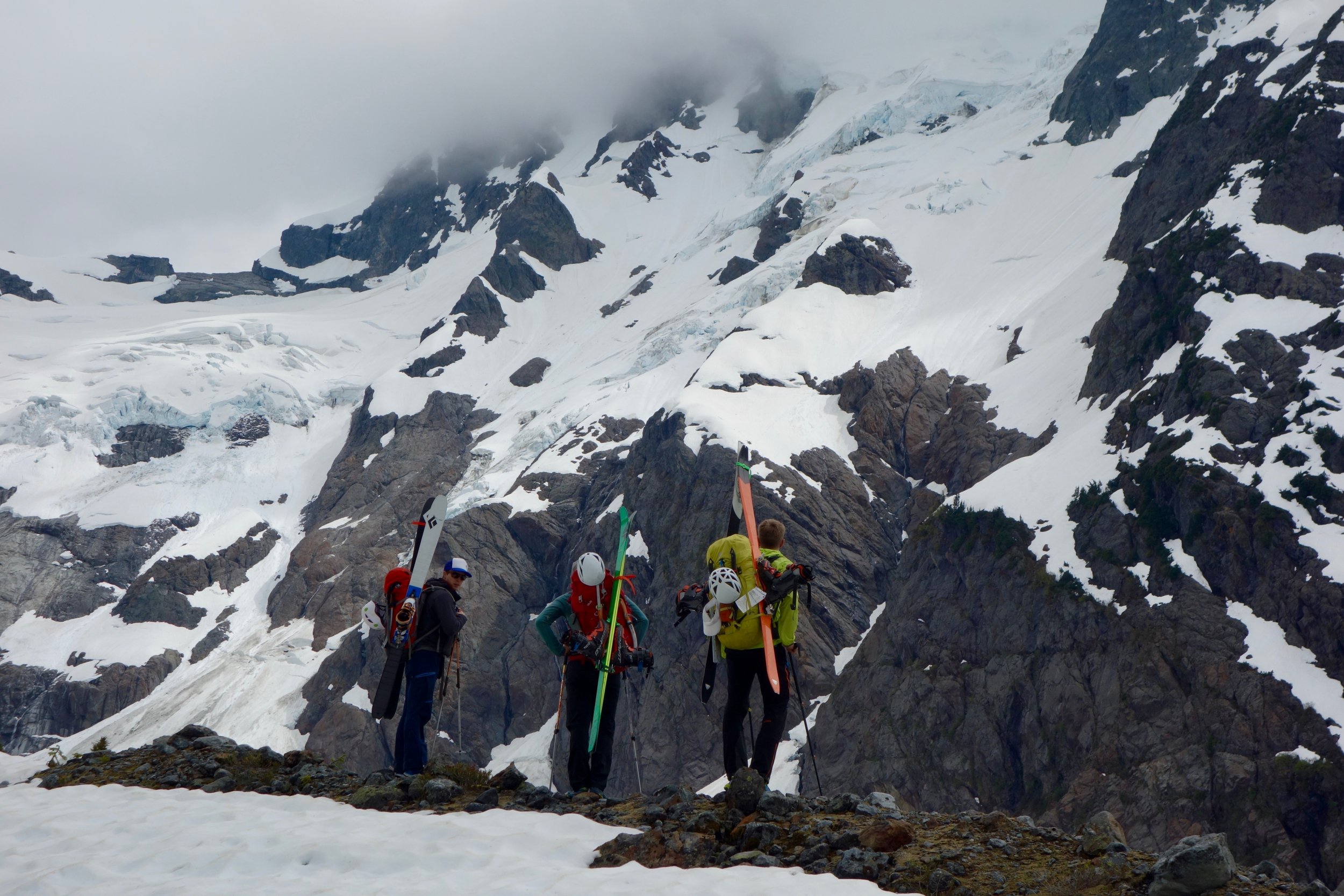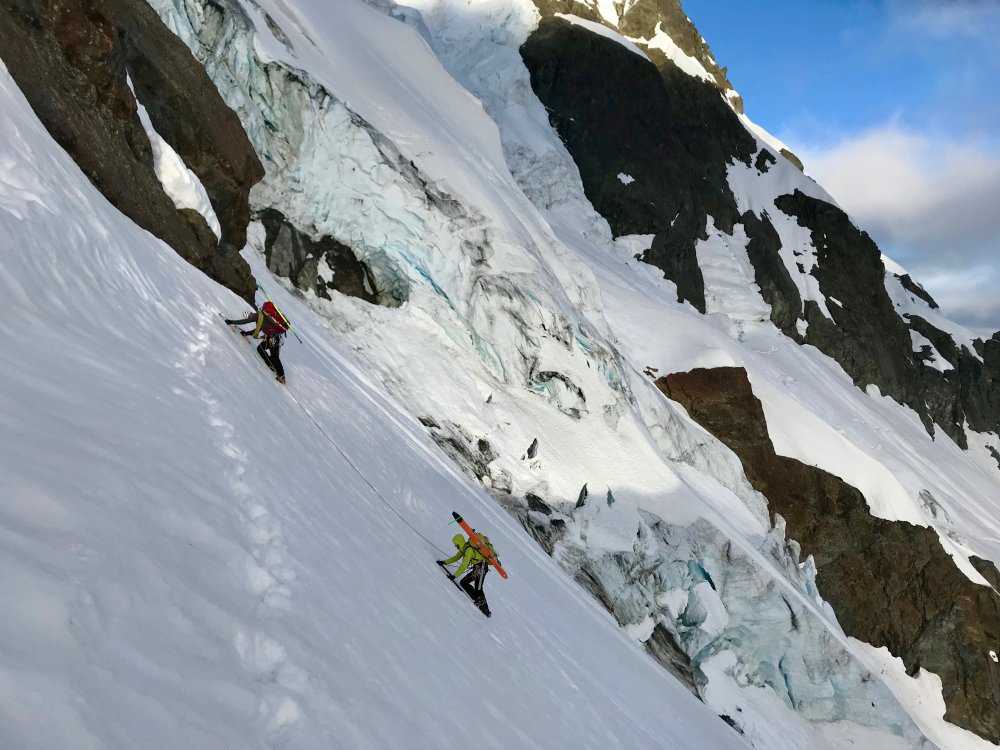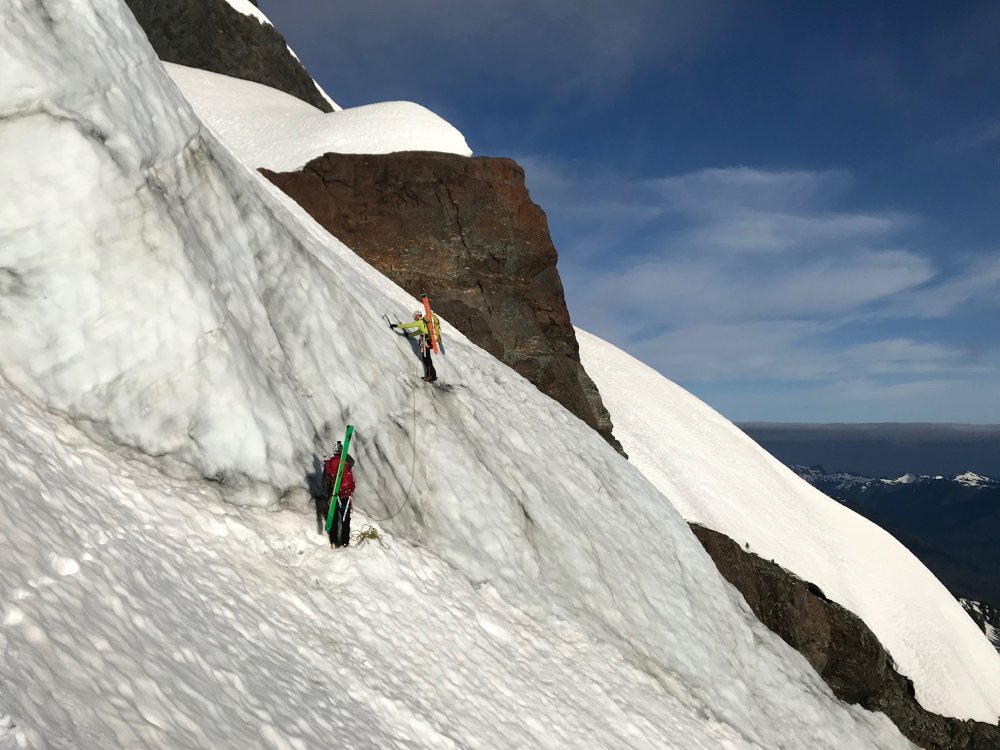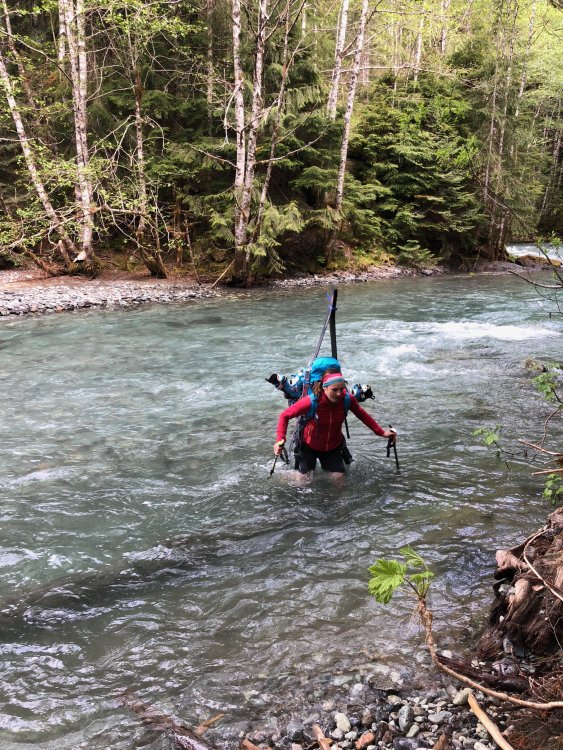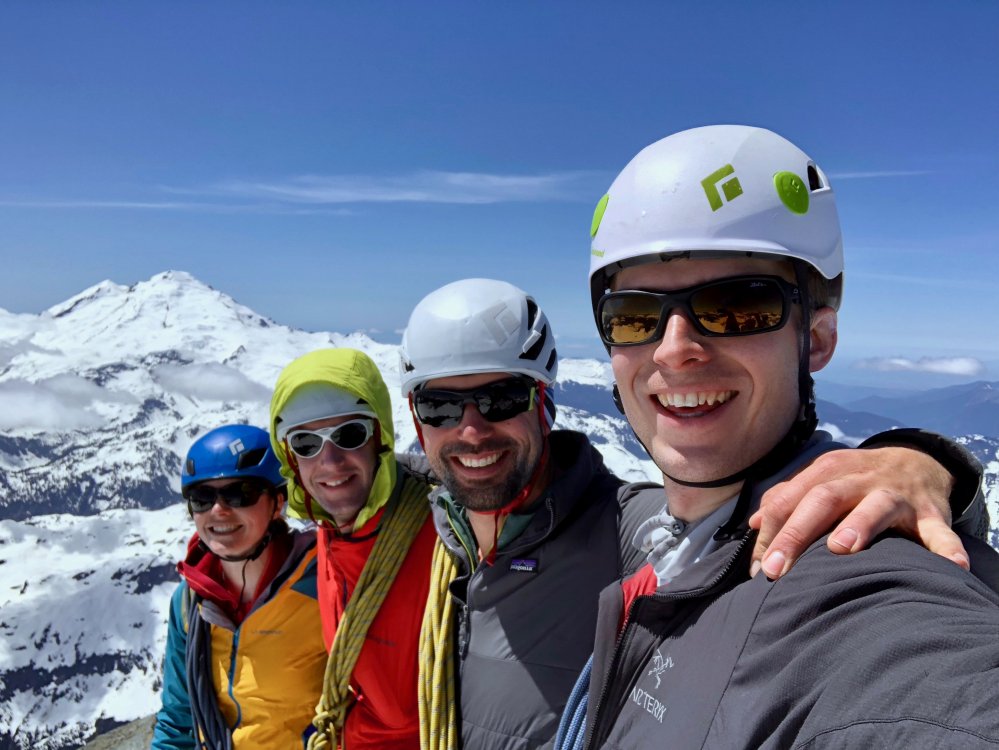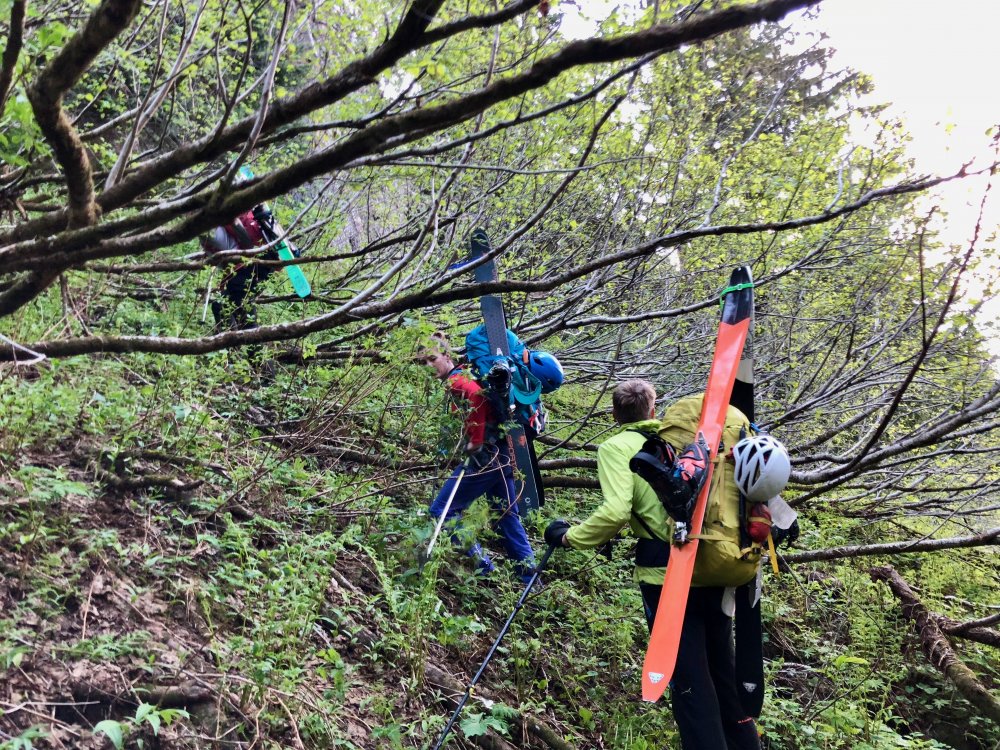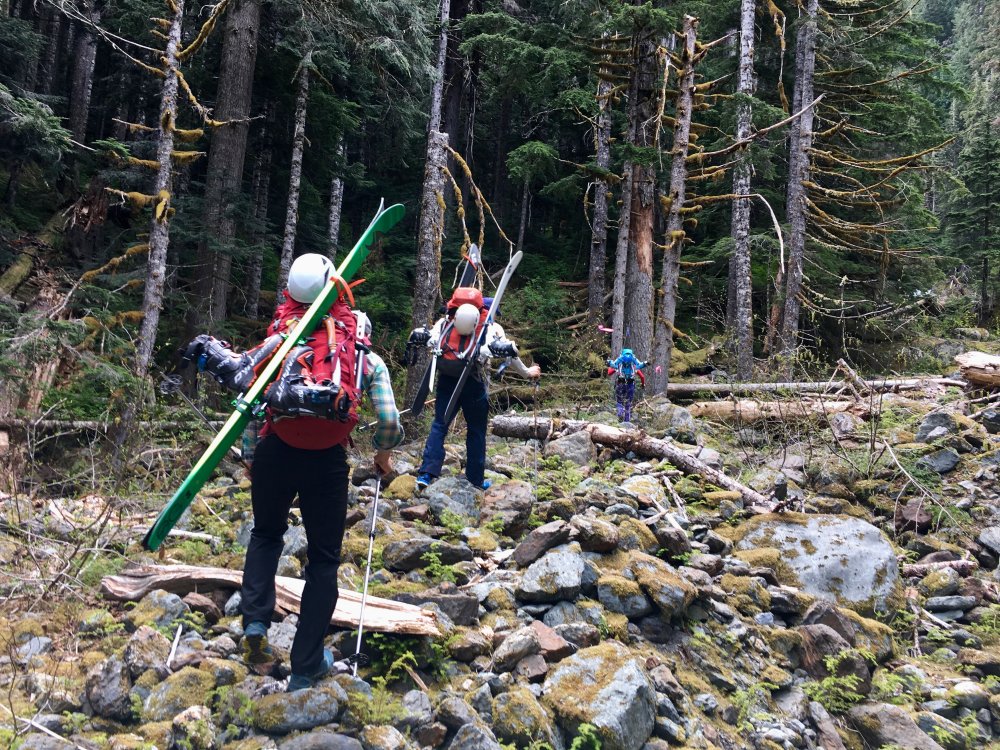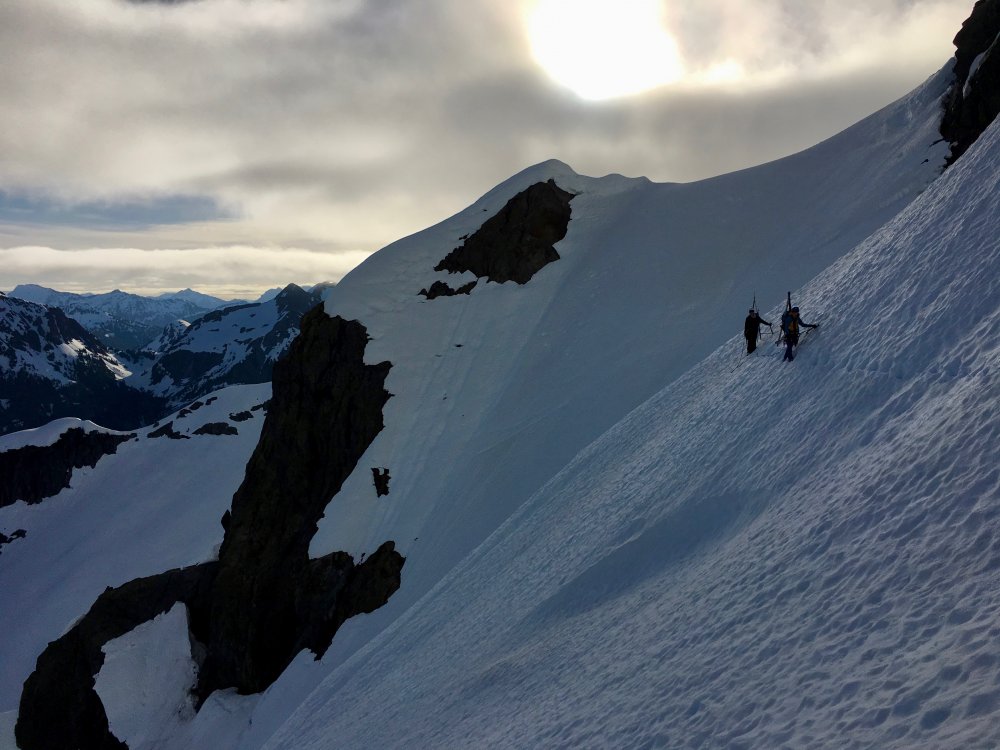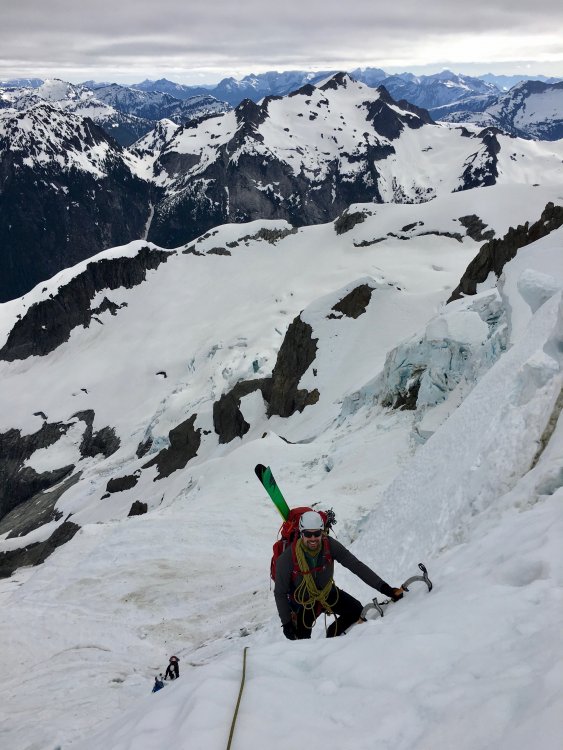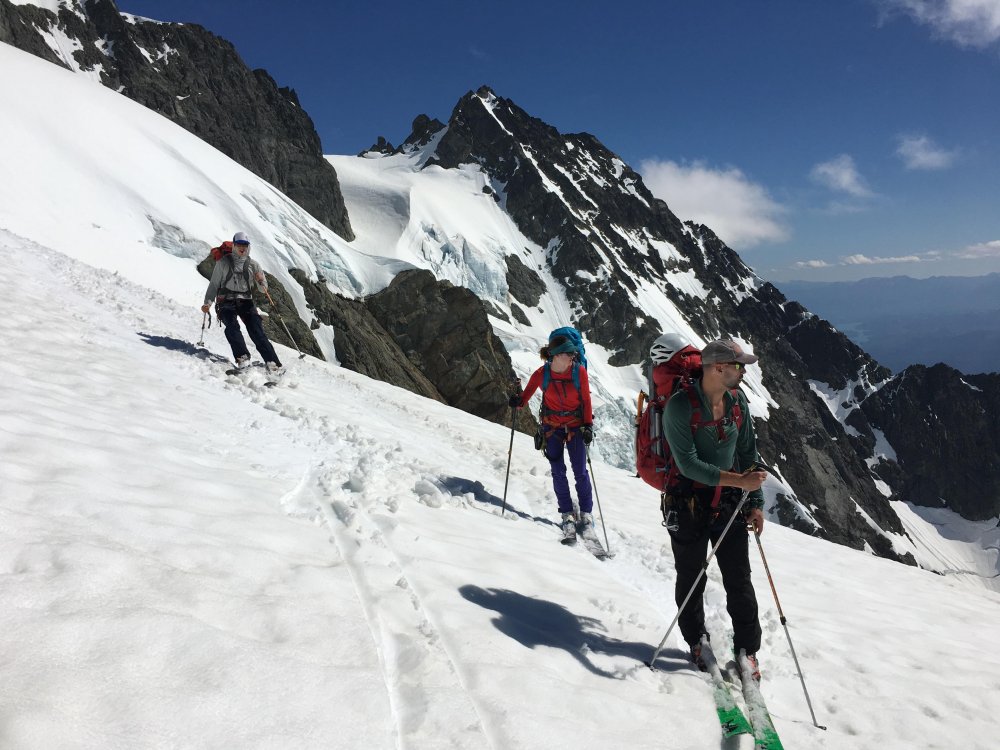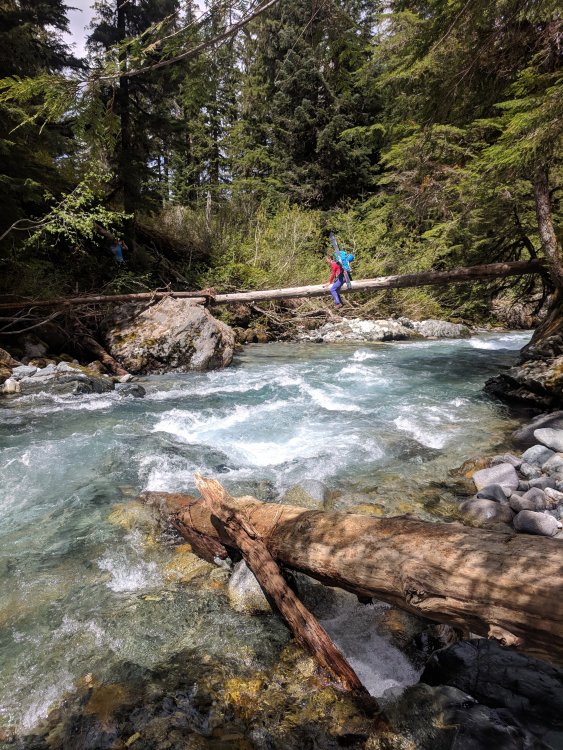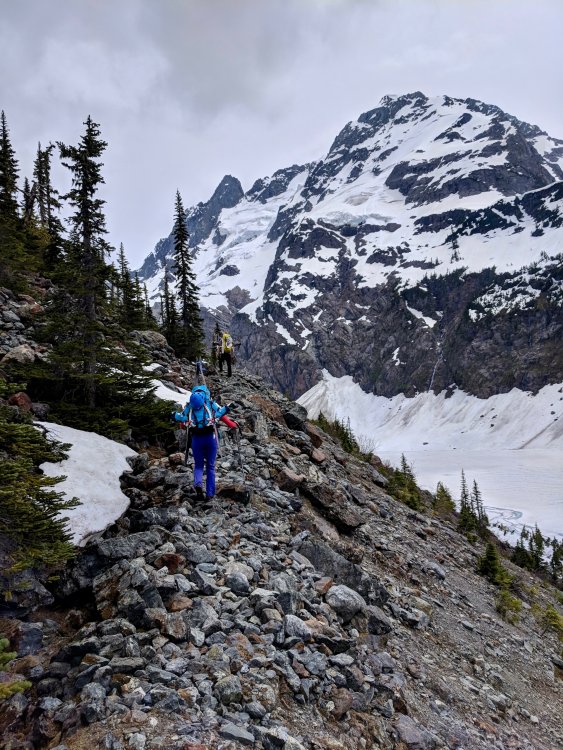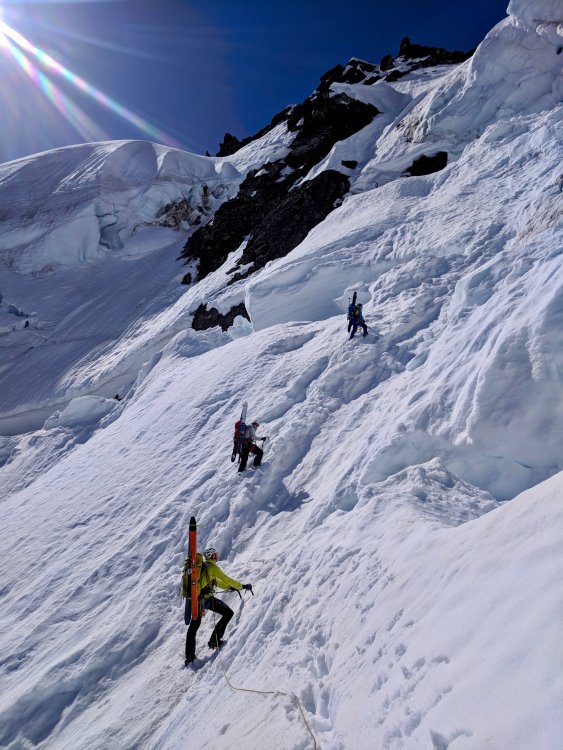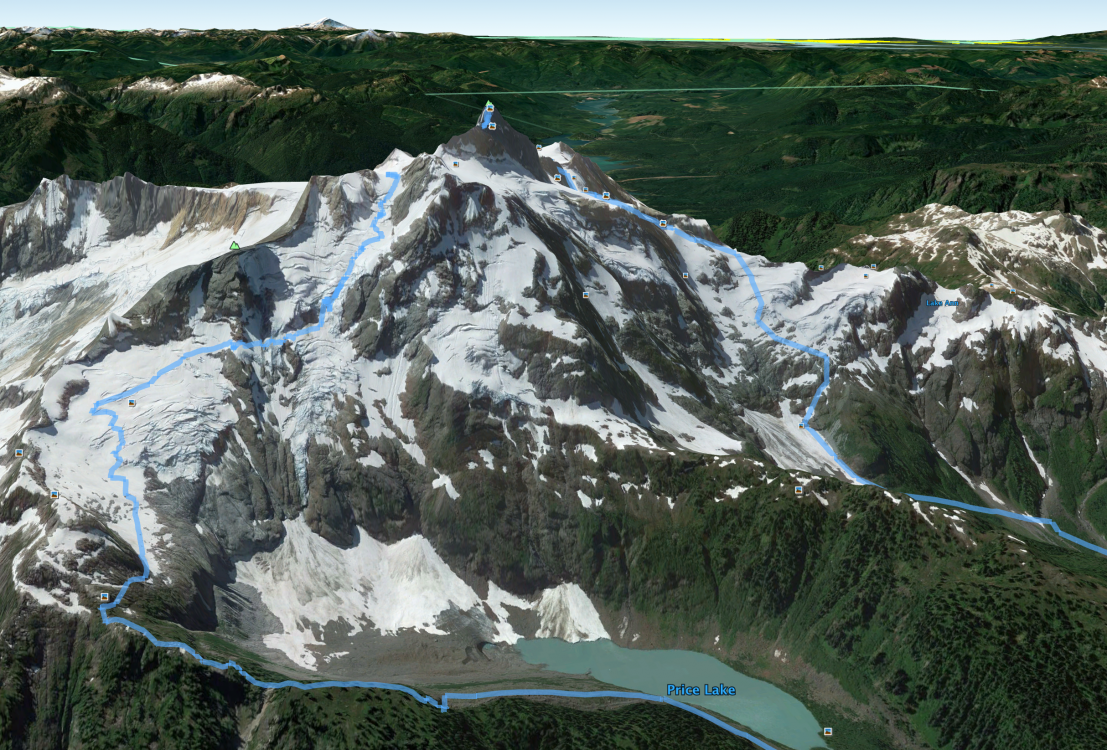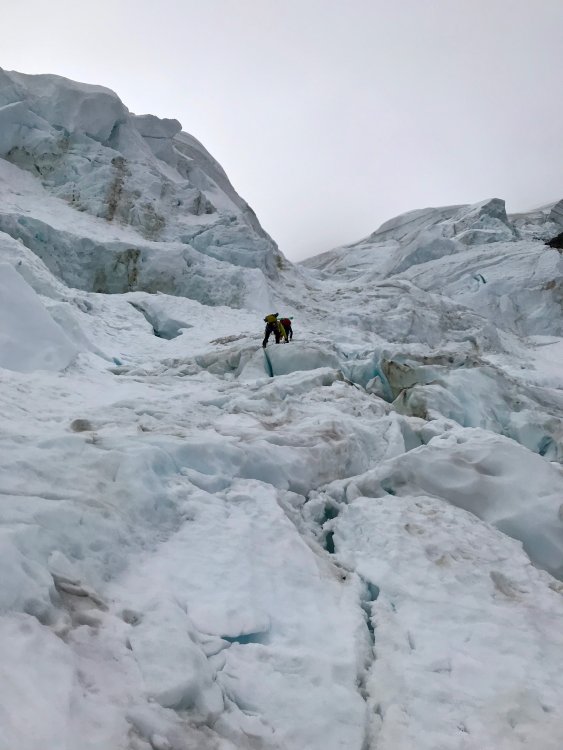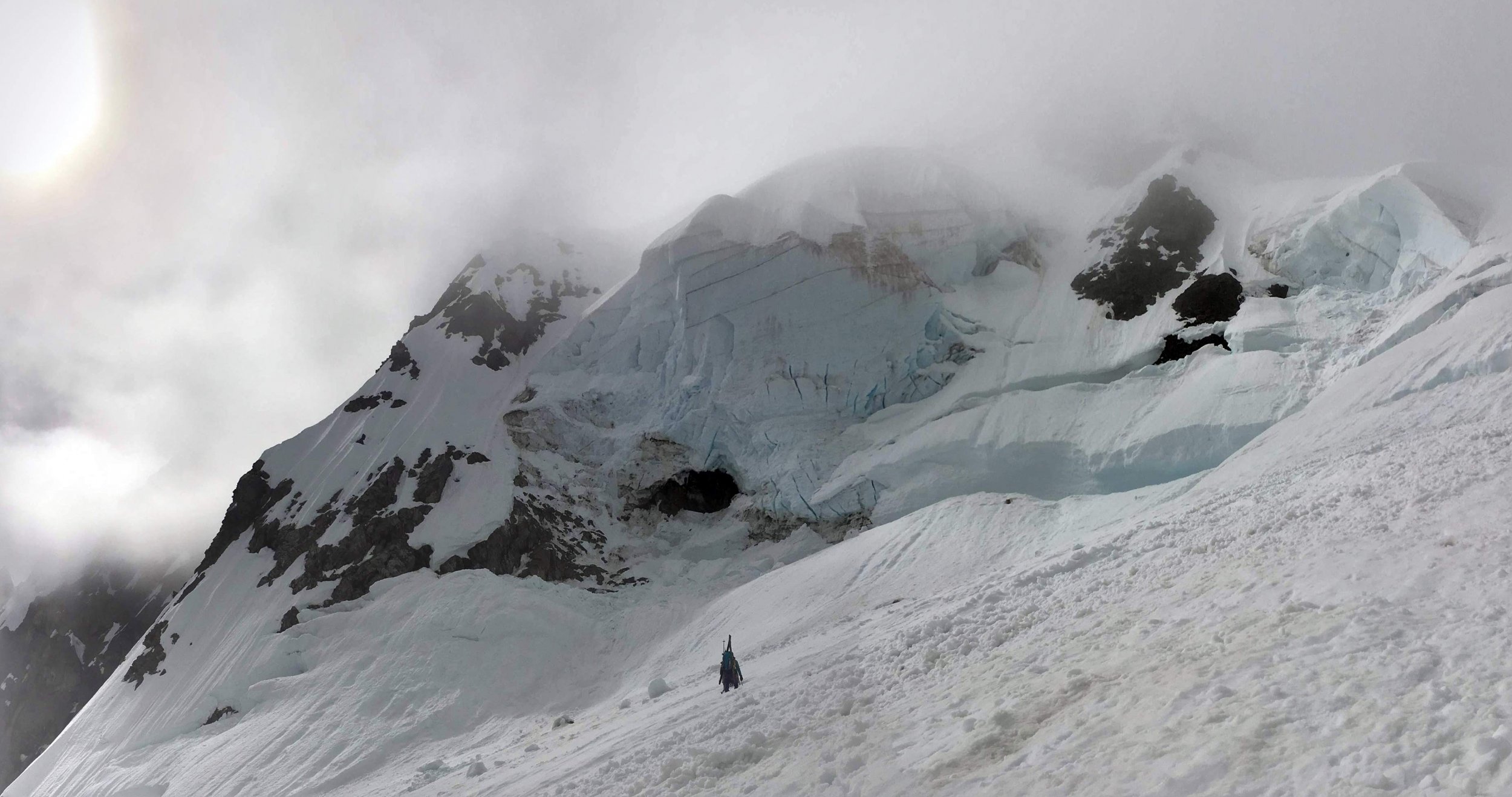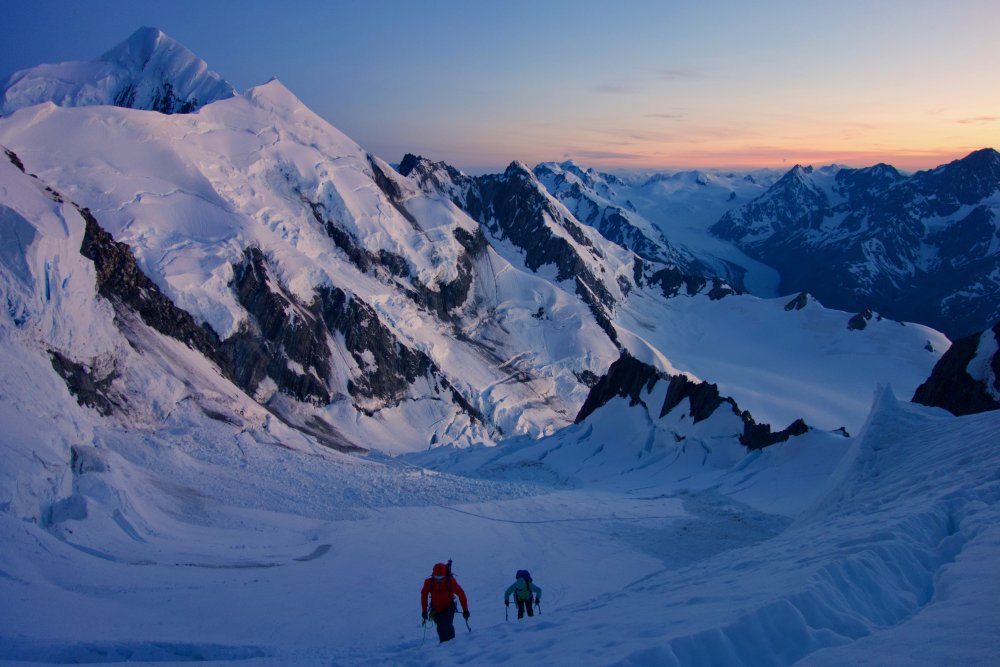-
Posts
48 -
Joined
-
Last visited
-
Days Won
6
Content Type
Profiles
Forums
Events
Everything posted by jefetronic
-
Thanks for sharing your story! It brought me vividly back to my experience on the route almost 10 years ago now. My most fond moments in the mountains have been those in which success seemed unlikely along the way, right up until we made it. Pushing through and succeeding, whether I did it 'clean' or not, was what mattered. Well done.
-
https://www.jeffreyjhebert.com/adventures/little-tahoma-via-paradise Found the person who lost their phone...last September. https://turns-all-year.com/trip-reports/little-tahoma-via-paradise
-
My partner and I found an iPhone sitting on rocks about 200 feet below the summit yesterday, May 13. I brought it home to Seattle and charged it (it was dead) but it does not have an emergency contact. Adorable lock screen photo attached. DM me if it's yours!
-
Trip: Glacier Peak - Frostbite Ridge Trip Date: 08/07/2022 Trip Report: TR and GPS track on my site here: https://www.jeffreyjhebert.com/adventures/frostbite-ridge-on-glacier-peak As the fourth-highest peak in Washington State and a beautiful, remote objective, I always wanted to climb more than just the standard route on Glacier Peak. With a perfect weather window over an early-August weekend and a good friend and climbing partner willing to suffer a bit, it was time. Adam and I drove out to the North Fork Sauk Trailhead on Saturday morning with open bivy gear, one axe and one light axe each, crampons, a 30m glacier rope, a few ice screws, a couple of pickets, trail runners, boots, and, perhaps most importantly, a good supply of whiskey. Our 3-day, lollipop plan was to hike 20 miles the first day to get near the start of the Kennedy Glacier, then climb the route and descend the Cool Glacier on the other side a good ways before camping again and then hiking out on the morning of the third day. We left the car at 10am and hiked up the standard approach until we hit the PCT, where we took a left up to Red Pass. We ran into a number of through-hikers on the PCT and each of them was a bit surprised to hear we were there to climb Glacier Peak. We also ran into a soloist who said he’d started up the Kennedy Glacier, but turned around. It was a bit ominous hearing that as we marched our way North on the PCT. The variety and amount of ground we covered this first day was pretty cool and we enjoyed it as much as we could despite the slowly-building pain creeping into our feet, shoulders, and hips. It was after 7pm when we made it to the tricky crossing of the Kennedy Creek. We just put our heads down from here and hiked up Kennedy Ridge to 5,300 feet where we expected to leave the PCT in the morning and saw a creek on the map, hoping there would be somewhere flat to bivy. We arrived at 8pm to find a nice little campsite with one other person, quickly set up shop, and conked out. The mileage and vertical gain from camp to the summit didn’t seem to warrant an alpine start, so we woke up at 5am and were moving by 6am. Heading straight up from camp was exactly the right move and quickly put us on a large moraine overlooking the entire North side of Glacier. There were some old signs of traffic, but the area had the feel of being forgotten and much more remote than other big peaks in Washington. We switched from trail runners to boots at the toe of the Kennedy Glacier at 7:30am, keeping crampons on our backs to start since the snow was reasonably soft and there was a clear dirty, rocky band to get through on the glacier below Kennedy Peak. This section was perhaps the most dangerous of the route—it was a crumbling mess with big boulders waiting to succumb to potential energy, perched on glacial till. After gingerly getting through this bit, we were on the wide-open Kennedy Glacier with very little crevasse hazard on its left half. Things were uneventful until we got to Frostbite Ridge itself. We could see the Rabbit Ears feature above us and our options were getting on a pumice treadmill up the ridge or staying on steep snow to the left. We opted to keep crampons on and stick to the snow. We stayed left past the first gendarme and on some of the steepest snow (~50 degrees) near the top, which went pretty easily with our second axes. The snow took us almost to the top of the face and then we scrambled a few feet to the highest point, just to the right of the highest gendarme (the Rabbit Ears themselves, it turned out) at 12:30pm. From here, we could see the rest of our route and it looked like it would all go. We could also see our 3rd class descent to the upper Kennedy Glacier. It looked loose and nasty, but ended up being quite reasonable and quick. The first 50 feet up the snow on the other side were steep, but it eased off significantly from there and we romped our way up, across, then down to the saddle below the final face. The face had the glimmer of ice to it, which was a welcome departure from walking. We determined the angle was low enough and the steep part short enough that it made more sense to solo than to pitch out. I set off and enjoyed settling into the flow of ice climbing despite the knuckle-bashing involved with straight-shaft axes. After the ice step of 40 feet or so, it was back to snow until the top, but it steepened up again right near the summit and made sense to front-point with both axes—quite fun to climb that way right to the summit. We arrived at 2:15pm. The descent was straightforward and pretty efficient on sloppy snow. We never needed the rope and took our crampons off as soon as we were down the initial steeper sections. We descended all the way to the plateau at 6,750 feet where we found a nice spot to camp off snow with great views. We got moving the next morning at 7:15am and were back to the car a little after noon. We stopped at the bottom of the switchbacks before the final flat slog out to consume most of the remaining whiskey and floated on a cloud of air most of the way back to the car. This route had a more adventurous, remote, wild feel than lots of other climbing in Washington. In a way, it felt more like a destination climb I would have flown somewhere to do. Yes, the walking to climbing ratio was quite high and we never took the rope out, but it did bring some fun challenges, stellar views, and time way out there. Gear Notes: Did use: whiskey Didn't use: 4 ice screws, 2 pickets, 30m rope, glacier kit Approach Notes: Buckle up
-
Trip: Mount Maude - North Face Trip Date: 07/23/2022 Trip Report: Kelsey and I were ready to move on from ski season but are in terrible rock climbing shape after pandemic years out of the rock gym, so we searched for snow routes. Mount Maude quickly shot up the list and we believed it would still be in shape despite it being late July, based on the snowpack we’d been observing this summer so far. We’d been up in the area to scramble Seven Fingered Jack before, and so the approach was familiar. We drove out Friday night in Kelsey’s van, getting a free, violent massage chair experience on the especially-bumpy access road, and conking out a bit after 11pm. We had decided that it would be nice to catch the route in slightly softened conditions and that its North-facing aspect should keep it from heating up too much, so we woke up at 5am and were moving by 5:30am. With just climbing gear, layers, and food for the day, we were reasonably light and banged out the approach to the meadow camp in Leroy Creek Basin in just over 2 hours. From there, we followed the climber’s trail until we hit snow, switched to boots, and made our way up to the Seven Fingered Jack / Maude col at about 10am. It was sunnier, warmer, and with less snow than we’d hoped on this side, but our view of the top of the route suggested it might still be in condition. We had a snack here, put on our harnesses and sharps, and started our downward traverse toward the route. We were on mushy snow for a ways before hitting a baked-out section for which we took crampons off and scrambled loose 3rd class until hitting snow coming down the North Face which looked more or less continuous. We got our crampons back on here at 11:30am and pulled out our second tools. The snow was softer than we were hoping for down low, but not demonstrating any signs of loose slide potential, so we scampered upwards unroped. The angle down low is quite reasonable in the 35-40 degree range. In the middle of the route, there was a brief bare traversing section we had to scramble through, but it was low-angled and pretty easy. From there, the route kicked up in steepness. We took our time, kicking in good steps, which varied in difficulty from a couple of kicks to five or six with some toe bashing. The last 75 feet or so was appreciably steeper and much more firm. We slowed further here to kick nice, secure steps. A nice consolation was that the firmer snow made for secure high-dagger tool placements. At 1:15pm, we crested the last steep snow of the North Face and high-fived on low-angle, rocky terrain that led to the summit. We had lunch and took a brief nap up here then started down at 2:15pm. After heading down the South Ridge for a ways, we decided to roll the dice and take a more direct, loose descent path to the West. It had efficient sections on loose scree and snow and a couple more painstaking sections on loose rock, but it went. By 4pm, we were back at the Leroy Creek Basin camp area and, by 6:15pm, we were back at the van for just under a 13-hour day. A fun day out, a beautiful area, and a nice transition out of ski season. The booter is in! I'd guess the route will still be in for another couple weeks (knowing how hot it's gotten since our ascent). Go get it. A few more photos and a GPS track are here: https://www.jeffreyjhebert.com/adventures/north-face-of-mount-maude Gear Notes: Soloed the route with crampons and two tools. Brought a few pickets, a few screws, and a 30m glacier line just in case. Only pickets would have protected it. Approach Notes: Head to 7FJ-Maude Col and then do a descending traverse across snow and loose 3rd class to ~7,750 to start the route.
-
Trip: Mount Baker - Park Glacier Trip Date: 05/30/2021 Trip Report: TR and GPS track here: https://www.jeffreyjhebert.com/adventures/park-glacier-on-mount-baker With a decent forecast over the long Memorial Day Weekend, Colin and I decided to put the work in to access the remote Northeast side of Mount Baker. It turned out we timed our trip quite well, being able to skin straight from the Heather Meadows parking lot at the Mount Baker Ski Area and encountering some tricky, but doable crevasse crossings near the top of the route. Expecting about 4-5 hours of approach, we left Seattle in the late morning, departing from the car at 1:30pm. It was hot in the bright sun as we climbed up to Artist Point and even hotter climbing up to the shoulder of Table Mountain without much of a breeze. We made it here in about 1h 20m from the car—not bad for schlepping overnight gear! The short descent toward Ptarmigan Ridge wasn’t worth transitioning for, so we awkwardly skied down the sticky warm snow and across to a point where we could start climbing again. We decided to stay relatively high and climber’s left along Ptarmigan Ridge. While this likely included a bit of extra up and down, we were able to stay with skins on all the way to the saddle next to Coleman Pinnacle, arriving in about 3 hours from the car. We did a curling traverse down and skier’s right from the saddle, keeping skins on again. This got us to what’s marked as Camp Kiser on some maps, which has a fabulous view of Shuksan. We decided to press on to The Portals, with one more awkward skins-on descent and one more climb before reaching our destination for the day after 4 hours on the dot (5:30pm). We dug out a campsite, set up shop, and enjoyed a lovely evening watching the mountain pink up. Knowing the upper Northeast-facing cirque would bake as soon as the sun rose, we got going decently early, skiing away from camp at 5am. There is a cliff band at roughly 6,150 feet which is tough to scope well from above. We eventually found an exit we could ski at the far skier’s right edge of our traverse from camp, then skied down onto the Rainbow Glacier. The snow was quite firm but the angle looked reasonable to skin all the way up, so we put ski crampons on. Our ascent of the glacier went smoothly, weaving around crevasses as we encountered them and using some photos we’d taken of the route from camp the evening prior. A big sulfur vent near 8,000 feet really completed the volcanic ambiance. At about 9,000 feet, we skinned up between two gaping crevasses running vertically down the mountain. At about 9,500 feet, we had to end run a big crevasse toward the North before swinging back left across the face. It was clear from here that the “moat” described in the ski tour guidebook as being “easy or difficult depending on conditions” was fully out and would easily fit a school bus. We’d expected to come back across the face to find a ramp across a high crevasse and this worked out well. The snow bridge crossing this final crevasse was a good 8 feet wide, spanning a narrow point about 10 feet across. The rest of the crevasse was much more open and it was a big one. I gingerly skinned across with Colin below me and the rope tight, thinking light thoughts until I was safely on the other side. I dug in and body belayed him across. From there, our final challenge was to make a traversing ascent of the headwall above this gaping crevasse. Thankfully, the snow was perfect for kicking in good steps and we just took our time. At 10,180 feet, I busted through a small cornice and onto the ridge above the Cockscomb. It was relatively easy going from there across ice and wind-affected snow. We reached the top at 10:15am, so just over 5 hours from camp despite that painstaking rising traverse. We celebrated briefly, explained where we were coming from to some folks coming from the Coleman-Deming, and then scooted back from whence we came to get back across that face and the snow bridge before things warmed much further. Thankfully both went well and we were able to enjoy a stress-free 4,000-foot ski back down the Park and Rainbow Glaciers. The snow was heaviest up high and improved the lower we went, with really fun corn on the bottom third. We skinned back up towards camp, booting the short cliff band and then side-hilling through south-facing slop. We arrived at 1pm and had a nice, leisurely lunch with some tea. Fresh socks were downright luxurious. The rest of our descent went smoothly, mostly retracing our approach line except for taking a lower route North of Coleman Pinnacle to avoid gaining unnecessary elevation. At 5:30pm, we arrived at the Heather Meadows parking lot and retrieved our stashed beers from a snowbank. Over 22 miles with a lot of traversing made for some pretty beat-up feet and we were very excited to exit our boots. Obligatory Aslan Brewery waffle fries and burgers capped off an excellent 2-day adventure. Gear Notes: Skis, crampons, axe, glacier kit Approach Notes: Buckle up for a long up and down traverse from the Mount Baker ski area
- 1 reply
-
- 2
-

-

-
No problem. Happy to help. I think we nailed the season. The snow was stable and firm, the guide companies had been sending clients up on most peaks already, and the weather was great—dry pretty much the whole time. Three weeks actually bordered on too much for us. After two weeks, we'd climbed everything on our initial three-week itinerary and we even considered flying home early or heading to another destination, but decided to just do one more peak. This was partly due to weather, conditions, and logistics all working out really well for us. My three-week trip to Patagonia felt too short due to difficult weather. Two-and-a-half weeks in Peru was also bordering on too short, given getting sick there. So three weeks is a good duration if you can swing it to buffer for the unexpected. We left Bolivia feeling like there wasn't much unfinished business. Other options for us were the West Face of Huayna Potosi and the Grand Traverse of Illimani. We would have done the latter if we'd been a bit more healthy and confident at the end of the trip. We considered Chachacomani, but it didn't sound terribly interesting. Ancohuma was a similar story. Sajama didn't sound interesting to us at all. I think Peru might have an edge if you're choosing between the two for a first trip: Huaraz is more of a mountain town with a scene focused on climbing, there are more route and peak options, and the climbing can be more technical (but there are easier options as well). La Paz is a big city and the peaks are generally less technical. Transportation is similar. Some approaches in Peru are bigger and make more sense to do with support (donkey drivers, etc.), which is an interesting experience. We did like the faster and lighter approach in Bolivia having experienced both, though. It's pretty cheap in both countries once you're there. I believe Bolivia has the edge on cheapness. We didn't hire a guide in either place, but we heard that Peru has "European rates" while Bolivia was surprisingly cheap for guides, porters, donkey drivers, and cooks from what we heard. Hotels were easily bookable online for both places in advance and costs were pretty reasonable. Bolivia was downright cheap. We found it was worth spending a bit more in Huaraz—our first hotel smelled like sewage and had a lot of street noise. Basic supplies where cheap in both places. For example, we bought standard butane fuel for our stove at 20 Bolivianos per canister in La Paz ($2.90). There are normal grocery stores in La Paz with staples. Huaraz had some smaller ones and you could buy things like oats, dried fruit, salami, etc. in the markets. Taxis worked in both places and were pretty reasonable (3-hour drive from Illimani was 450 Bolivianos / $65) and some transportation made sense to do in Collectivos in both places, which are dirt cheap. Looking forward to hearing about your adventure down there. - Jeff
-
We did the trip in La Sportiva G5 boots. I've found them to be a touch warmer than my old Nepal EVO boots since the shank is carbon instead of steel and it's easier to loosen them on the fly if cold. There were a few times when my feet got a bit numb (primarily in the early morning while front-pointing up the headwall on Illampu), but the G5s worked well. We saw a lot of people in Spantiks and other double/plastic boots. Similarly, neither of us needed alti mitts—we got away with heavy BD gloves (and some numb fingers at times). In terms of gear, we had a whole spreadsheet down to the earplugs, but here's the key stuff: Climbing G5 boots; trail runners for approaches Dual horizontal-point crampons Quark tools & spinner leashes Lightweight harness and crevasse rescue kit Pole and whippet (really nice for approaches/glaciers/low-angle stuff) Speed 50 pack 30m x 8mm glacier line for most everything (brought a 70m lead line for Illampu; brought a 70m tag line down there, but didn't use) A few slings and screamers (just used a couple) 8 ultralight screws (didn't use; carried often) 5 pickets (usually brought 2 unless more technical) Some nuts (didn't use) Some pins (didn't use) Avy gear (didn't bring out as the snow was stable) Camping Firstlight tent (we brought an Eldorado as well, but didn't use since the weather was great; a groundcloth might have been nice) Xtherm pad and -10 degree down bag (turned out to be overkill, but oh-so comfy) Reactor stove and Katahdin BeFree water filter
-
Trip: Bolivia - Cordillera Real - Pequeño Alpamayo, Cabeza de Condor, Huayna Potosí, Illampu, and Illimani Trip Date: 05/26/2019 Trip Report: I just returned from a 3-week climbing trip to Bolvia and figured some folks here would be interested in hearing about the climbing down there. We stayed mostly healthy, had perfect weather and conditions, and the logistics went smoothly, which made it possible to pack in a lot of climbs: May 26 - Arrive in La Paz May 28 - Pequeño Alpamayo (17,618') - West-Southwest Ridge (III, AD) May 30 - Cabeza de Condor (18,530') - Southwest Ridge (III, AD+) June 2 - Huayna Potosí (19,974') - French Direct Route (III, AD+) June 6 - Illampu (20,892') - Northwest Headwall to Southwest Ridge (III, AD/AD+) June 12 - Illimani (21,125') - West Spur / Normal Route (II, PD) June 15 - Depart La Paz My partner and I had previously done similar trips together to Patagonia and Peru, so we felt comfortable designing our own itinerary and climbing alone without guides. I'd recommend this for experienced climbers who appreciate a "faster and lighter" mentality (and only if you have at least one person who can speak enough Spanish to get by). We bought Yossi Brain's 1999 Bolivia Climbing Guide and found enough beta online as well. We did a healthy amount of Google Earth scanning to identify camps and approach trails too. In my trip reports linked above, I've included Strava links with our GPS tracks to save others some trouble (just ignore if you want more suspense : ). In terms of logistics, we flew into La Paz, which is crazy city of nearly a million people in a valley with another million or so on the sprawling altiplano called El Alto. The city is an interesting experience in contrasts, with everything from folks living in dirt-floored huts to a shiny cable car system. La Paz is about 12,000' depending on where you stay and El Alto is about 14,000'. We opted to rent an Airbnb in La Paz for the whole trip as a basecamp (at ~$30/night, this was pretty economical). We started in La Paz for 3 days / 2 nights to acclimate before our first objective, which we deliberately chose to be one of the shorter peaks (Pequeño Alpamayo at 17,618'). This worked well for us. We slowly ratcheted up the elevation over the course of the trip and never felt worse than headaches and throwing up breakfast once. You can hop into the links above to hear more about our experiences and the routes. I've put a few pictures in here to whet your appetite! - Jeff Gear Notes: We brought 5 pickets, 8 ice screws, some nuts, and some pins, just in case. We ended up placing pickets only once or twice on the trip and simul-climbed or simul-soloed almost all of the terrain. Approach Notes: See each trip report for some details on how we got there and a GPS track.
-
Trip: Colchuck Peak - NE Buttress (Kearney) Trip Date: 06/23/2018 Trip Report: A few years ago when I got Alan Kearney's Classic Climbs of the Northwest guidebook, I was a bit surprised to see an unfamiliar route on a familiar peak—the Northeast Buttress on Colchuck Peak made Kearney's short list of 51 routes, so it had to be good but I hadn't heard much about it. A bit of searching on Cascade Climbers yielded a mixed bag, especially when considering the original Beckey line. In either case, the route went onto my list. Adam and I had talked about climbing together many times before, but it hadn't yet come together. He reached out early this week and we hatched a plan to car-to-car the NE Buttress (Kearney version) on Saturday. We drove out to the Stuart Lake Trailhead late on Friday night and got a little sleep there with alarms set for 5am—we were guessing that we could do the route in about 14 hours, but also knew we had a lot of daylight in case things weren't so fast. We started the approach just before 6am and went pretty fast. 2 hours in, we were on the far side of the lake on our way up the moraine. A little shy of 3.5 hours at 9:15am had us at the base of the ridge after enjoying continuous snow from the moraine up. We each had strap-on crampons on our approach shoes and light axes. The approach After consulting the beta a little, we located the first pitch of Kearney's start and racked up below it at the toe of the buttress. We'd brought rock shoes and a rack to 3 with doubles of .5 through 2. Adam took the first pitch at 10am and had a great time on the wide, broken crack on solid rock after traversing around some snow on sandy terrain to get there. I then did a very short pitch to the top of the crest. From there, it looked like the line might go lower later in the season, but the couloir snow convinced me to stay on a ramp system just a bit higher. After down-climbing a little from the crest, I traversed over and made a fun, steep move to get onto more solid granite which I ran right, then up a seam, and then back left to a ledge for the belay. Pitch 1 and Pitch 3 Pitch 4 turned out to be a bit of a low point. Adam set off and quickly encountered some moss and dirt on his traverse to the main dihedral. Sections of the pitch were really fun while others had a bit too much dirt and loose gravel. We knew we were on the right track, though, due to a couple of fixed pins we passed along the way. It took quite a while for Adam to find the way and stay safe on this pitch and it was 1:30pm before both of us were on top. The ledges We switched to approach shoes and doubled our rope in half for the ledge systems. I headed across and found that the rock quality and number of trees in the way reduced after the first pitch or so. It was actually pretty fun to move fast and link 3-4 pitches in one block. On a nice ledge before the route turned up the wall, we put our rock shoes back on and tied into each end of the rope. Adam did a quick bump of our belay to the base of the crux pitch and then set off. With our 70m rope and about 15 feet of me simul-climbing at the end, he was able to reach the ridge crest, linking pitches 9 and 10. I followed the pitch and had a great time—the rock was solid and the movement was varied and interesting. It meandered left before traversing back right and then into a left-facing corner all the way to the ridge. We were both on top of the crest at 4:30pm. Looking down the crux pitches, the buttress crest, and the final pitch Back in approach shoes, I linked pitches 11 and 12, getting us up the buttress crest and onto some ledges below the headwall. Views back to the belay on the ridge crest and Colchuck Lake were stellar. Adam bumped us up to the headwall and, after a few minutes of searching, we found a rightward traverse under big blocks for 80 feet or so on ledges to the North-facing dihedral that would bring us to the top. I took this pitch, having a ton of fun in the early evening sun and finding edges and gear anywhere I wanted them. I ran out of rope and gear just below the top and Adam headed through and brought me up. One loose block that had seemed solid when I banged on it with my hand decided to go as I mantled to the top and I had to jump out of the way, spraining my ankle a little trying to land on a foothold—thankfully the rock sailed right by me. We topped out a little after 7pm for about 9 hours on the route—a bit longer than we'd expected, but we hadn't been rushing and instead had been feeling pretty casual throughout. We started down by 7:30pm on dirt and rock to the col and then continuous snow down the glacier (skier's right fork) until a few hundred feet from the trail. It was 8:45pm when we got to the corner of the lake at the end of the boulder field. We only stopped once on the way out to numb ourselves a bit with bourbon and take in the sunset hitting Dragontail and Colchuck. We were at the car a little after 10:30pm for a little less than 17 hours on the day. While there were a few moments on the route where dirt, moss, lichen, and loose rock detracted, so much of the route was good climbing on good rock with a great position and view. We agreed that it was more interesting and sustained than the Serpentine Arete on Dragontail (which did not make the Kearney guide...). This TR on my site: https://www.jeffreyjhebert.com/adventures/ne-buttress-on-colchuck-peak Gear Notes: Single rack to 3 with doubles .5 to 2 worked well for us to do link pitches and simul-climb Approach Notes: Approach shoes, strap-on crampons, and light axes were fine
-
Trip: Mount Shuksan - Price Glacier Trip Date: 05/27/2018 Trip Report: A little more content is up on my site here: https://www.jeffreyjhebert.com/adventures/price-glacier-on-mount-shuksan The 50-classic Price Glacier on Shuksan had been high on my early summer alpine climb list for a number of years, but conditions, weather, and logistics hadn't yet aligned for an attempt. With Owen flying up to Seattle for a long weekend of climbing over Memorial Day weekend, it seemed like a worthy objective. During our research and planning, we were concerned that most trip reports had been from later in the season (typically July or even August), but it had been such an unseasonably warm spring that I figured the timetable was accelerated by roughly a month. I'd also been on Shuksan a few weeks earlier via the Sulphide and gotten a feel for the conditions. Our other concern was the recent wet slab activity on the persistent weak layer in the area (and even on the White Salmon—a similar aspect and at a lower angle) and the potential for warm temperatures and sunshine making the snow wet at best. About a week before, Eric decided to come up as well and we made it two parties of two on the adventure with Kelsey joining as well. We had a good group debate about the route selection as well as whether or not to bring skis—there was a good possibility of walking the skis in, carrying them while climbing technical ice in ski boots, and then 'schwacking them back out. In the end, we decided to do the Price and bring skis. Game on. We left Seattle on Saturday morning at 6:30am and stopped at the Ranger station in Glacier for our permit where we learned that the first log across Ruth Creek was out. Not the best way to start things off... We drove one car up to the gate just outside the White Salmon Ski Lodge parking lot and then headed down to the Nooksack Cirque Trailhead where we geared up and started off just shy of 11am. We immediately forded the river barefoot in shorts. It was invigorating, but not terrible. Just over an hour on the trail got us to a faint climber's trail heading down to the North Fork of the Nooksack. We followed flagging tape to the river and saw the famous log crossing upstream. After a nice lunch, we each shimmied across the log, which is nicely angled downhill and relatively smooth. Really well-set flagging tape marked the whole way up to Price Lake. We were expecting this portion of the approach to be pretty painful, so when we made it from the log crossing to the opening at Price Lake in only an hour and a half of pretty open, steep trail, we were pretty surprised and happy. We stuck to the moraine and started getting intimidating views of the mountain and Price itself, though a ceiling of clouds shrouded the top of the mountain and route. Kelsey fording Ruth Creek, the famous log crossing, and entering the trees on our way up to Price Lake After a ways up the moraine, we got onto consistent snow and decided to start skinning. At the first major rise on the ridge, we were worried that the snow wasn't continuous staying low as was suggested in some reports, so we headed up to the crest with skis on our backs again. This worked, but proved to be a bit of extra energy as we gained and lost some vert following the crest. At about 5,400 feet, we ran into a party of three also approaching for the Price, but without skis (we weren't expecting company on this route), and ended up following them across and down to gain the glacier at about 5,200 feet on what were likely rock slabs in the summer, but was continuous snow for us. After booting a ways, we switched back to skinning and went up to a nice flat area on the glacier at about 6,150 feet where we set up shop for the night after being on the move for about 7.5 hours. Ascending the moraine on the approach, catching our only views of the route before it got socked in for the rest of the day The cloud cover which had been covering the top of the route during the approach had slowly lowered during the afternoon and eventually socked in our campsite as well. Over dinner, we discussed our options and decision points in the morning. We also celebrated my birthday, including a pan of brownies with candles that Kelsey had hiked in. They were awesome! It was decided that we'd wake up at 3:30am and have a look. If we were still socked in, we'd snooze for an hour and then at least pack up and go to the saddle to see if it'd clear before bailing if we had to—none of us thought it wise to attempt the route in a whiteout after not being able to fully scope it out on the approach. At 3:30am, the sky was much clearer and, while there was a decent amount of cloud cover, it seemed like it'd go. We took our time packing up, hoping things would improve a little and knowing that the clouds would help keep the snow in better condition. We started moving at 5:30am and gained the saddle in 30 minutes from camp. We descended and traversed from the saddle, getting across some steep snow and broken ice to reach a patch of low-angled blue glacial ice that we'd scoped out during the approach as what seemed to be the path of least resistance. I took the ice pitch and had a lot of fun swinging the tools and plugging in screws. Traversing from the saddle to the ice step and going up the fun ice step From there, we traversed underneath some menacing ice cliffs and then decided an ice and snow gully going up and right looked like our best bet. It got us out of the direct objective hazard pretty quickly and was quite fun with mostly neve and some ice, protecting with an occasional screw when things got steeper. The gully continued up, across lots of broken terrain and through a series of steeper and gentler steps before depositing us on the upper glacier. We all breathed a momentary sigh of relief knowing that most of the danger and difficulty was behind us, with the key exception being the bergschrund. The steep snow and ice gully and getting close to the bergschrund Eric and Kelsey swung into the lead at this point, returning the favor of the boot pack and taking on the warming upper slopes. The clouds cleared and it got downright hot. We were really excited to see that the very left edge of the bergschund was sufficiently filled in to enable passage and let out some whoops as our line came into view and we knew we could get through the last bits before things got much warmer. A few switchbacks and steep snow got us onto the final slope to the saddle and then the saddle itself about 5 hours and 45 minutes from when we'd left camp at about 11:15am. Woo hoo! We regrouped briefly and then skinned around to the South side of the summit to get our last bit of steep snow done before things warmed further. The summit had baked out a lot since my trip up a few weeks earlier, but the gully was still mostly snow except for a few rock moves in the middle and then again at the top. We got to the summit at 1:30pm and took in the (thankfully) clear views of the range. The down-climb went smoothly and we clicked into our skis to begin our descent 9 hours after we'd started at 2:30pm. The turns were fun and pretty buttery down to and through Hell's Highway. We skinned up the Lower Curtis and then skied down to the camp above Whinnie's Slide, getting there at about 4:15pm. Summit! Skiing down the Upper Curtis Glacier on our way to the White Salmon We'd brought provisions to spend the night there, but were all pretty happy with the snow conditions to that point and knew we had lots of daylight left, so we decided to rest a bit there in the sun and then continue our descent. We left the camp area at 4:45pm and were down the whole White Salmon Glacier in less than 30 minutes, enjoying buttery snow the whole way, even on the wet slide debris lower down. The snow ended up being continuous and skiable all the way down to 3,150 feet, but we knew that there was some 'schwacking to be done from there on out. The 'schwack After refreshing ourselves with glacial melt and switching back to trail runners, we started battling the shrubbery. It wasn't too bad in the valley at first, but we never found the faint trail in the old timber and proceeded to battle slide alder, tight trees, and steep mossy slopes for about 1 hour and 45 minutes until we finally reached the road, exasperated but happy to be through the business. The cat track walk was quick and we reached the car shuttle with much-needed beers and snacks at 8:45pm, a little over 15 hours after we'd started. In my opinion, in the conditions we experienced, I can see why this route got the 50-classic nod. The Nooksack Cirque is gorgeous. The route is a very aesthetic and obvious line through steep, broken, glaciated terrain. Going point to point means traversing much of the mountain, regardless whether descending Fischer Chimneys or the White Salmon Glacier. There is some objective hazard on the route and it's clear that conditions can vary widely, making this a tough one to get just right. Thankfully, it seems that we did! Our track up and down the mountain Gear Notes: Brought 6 screws, 2 pickets, 4 cams, 3 pins, and a small set of nuts. Used 4 screws and 1 picket. Carried skis and lucked out with the amount we were able to skin and ski. Approach Notes: First log across Ruth Creek is out, requiring a ford. Pink and orange flagging tape mark the way off the trail, across the North Fork of the Nooksack, and up to Price Lake
-
Thanks! We planned to climb Tasman while we were up on the Plateau, but the weather closed in after we climbed Cook and we heard from some guides that the route was out. We also planned to do Aspiring later in the trip, but the weather stayed quite unsettled, so we drank wine and ate cheese near Wanaka and Queenstown instead.
-
Trip: Aoraki Mount Cook - Linda Glacier Trip Date: 12/07/2017 Trip Report: For anyone interested, I recently traveled to New Zealand and successfully climbed Aoraki Mount Cook via the Linda Glacier, approaching from the valley floor via Ball Shelter and the Boys Glacier. Trip report and photos here: https://www.jeffreyjhebert.com/adventures/linda-glacier-on-aoraki-mount-cook Gear Notes: Pickets, screws, nuts; 2 tools; crevasse rescue gear; 70m single line Approach Notes: Just about everyone takes a helicopter to Plateau Hut these days. We hiked in. Due to to glacial recession and erosion, it's unsavory and somewhat dangerous to do so.
-
Trip: Inspiration Peak - East Ridge Date: 8/20/2016 Trip Report: We planned our adventure on Thursday night, left Seattle around 8:30am on Friday, grabbed permits for the Terror Basin, and started hiking up Goodell Creek at about 12:30pm. Much has been written about the intensity and duration of Pickets approaches, so we were mentally prepared for a slog. Thankfully, a pleasant 1.5 hours along the creek with some brush, but nothing crazy, took us to the turn uphill. While it was steep and unrelenting for nearly 4,000 feet, it really wasn't that bad either. Perhaps deciding to not carry a tent, given the forecast, helped a bit. At 5,200 feet or so, we got our first full view of the Terror Glacier basin and our objective. It was striking and motivation enough to make the long, open traverse to the saddle at 6,200 feet and descend to camp, where we arrived at about 6:30pm. We met one other party of two there who decided to go for Terror. Another party of two came in after we'd set up camp; they were headed for West McMillan. Behind them was a party of four who were also aiming for Inspiration's East Ridge. We got to bed early, woke up a little after 4am, and were on the move a bit after 4:30am. The benches weren't hard to navigate in the dark and we eventually made it to the outlet of the lake below McMillan before starting to head up slabs toward Inspiration. A little after 7am, we had crampons on and were crossing snow toward a narrow snow ramp which we hoped would take us to the upper glacier and the base of the route. After getting most of the way up it, we decided that it was too tenuous--the snow bridge wasn't very thick, the ice was pretty steep, and the crevasses below us were big. We headed climber's right to the rock rib separating McMillan and Inspiration instead. It was mostly 4th class with a few 5th class moves. It brought us exactly where we wanted to go--to the upper glacier just a few hundred feet from the base of the route. We quickly traversed over and found a thin tongue of snow laying up against the face with significant moats on either side across the whole face. Lucky! The first few hundred feet of the route were engaging, but forgettable. The climbing was pretty steep for approach shoes with packs and we gingerly simul-climbed our way up until things eased near the top. At the top of the saddle, we switched to rock shoes for the crux pitches and thoroughly enjoyed the first 5.8 pitch before arriving at a lovely ledge below the crux with stellar views from the Northern Pickets all the way around to Glacier Peak. We could see our friends cruising up West McMillan Spire as well. Dale set off on the crux pitch and couldn't contain his joy, belting out comments about how awesome the hand jams were. The climbing was pretty physical with packs on and the crack was awesome, ranging from wide hands to perfect hands. I seconded and took a look around at every rest. The climbing would have been an amazing pitch on its own at Index, but to be on that face with that position in the wild Picket Range was something else. We finished the pitch with high fives and many a superlative uttered. From there, it was easy ridge scrambling to the summit. We switched back to approach shoes for the ridge and were glad we did. It was 12:30pm when we hit the summit, so we decided there was time for a short nap after lunch, and then it was time to begin the tedious descent. 3 double rope raps off the summit down the West Ridge got us to a station above the South Face. The rap from there was nearly a full rope length free hanging before touching down a little bit above the next rap. Invigorating! The rest of the raps went without incident, as did our long end run across the glacier to make it through the maze of crevasses (photos from the summit were helpful). We retraced our steps from the morning at that point and were back at camp around 7pm to make dinner before dark. After a leisurely start on our last day, we thoroughly enjoyed our descending traverse out, including foraging a bunch of wild blueberries. The hike down the steep ridge really wasn't that bad and put us back at the car at about 2:30pm. View of our objective from camp the first night Approaching the broken-up glacier The crux pitch. Stellar. Photo by Dale Apgar. More of the crux pitch. Photo by Dale Apgar. Heading up to the summit Summit view. Photo by Dale Apgar. Looking back at Inspiration while end running crevasses on the way out The view back on our hike out Gear Notes: Single rack to 3" with doubles of .75 through 2. Bring some cord to back up raps (and a knife to take down some of the old stuff) Approach Notes: Glacier is pretty broken up. We ascended the rock rib separating West McMillan and Inspiration. The moat is large, but currently manageable with a snow bridge in one place.
-
It was easier than we expected it to be to gain the rock ramp. The glacier was quite broken up at the base of the ridge and we had to front-point up some sections of icy glacier, but the moat wasn't bad at all for us.
-
Much appreciated! All set now.
-
The CC TR tool seems to be busted. TR here: http://www.jeffreyjhebert.com/adventures/nw-face-on-forbidden-peak
-
The statement in Blake Herrington's new Cascades Rock book seemed improbable. "The Northwest Face is Forbidden's best route." When comparing to my experiences on the 50-classic West Ridge via the TFT, gendarme-laden East Ridge, and long alpine adventure that is the North Ridge, I was a bit skeptical, but had to see for myself. Eben and I decided on our objective on Saturday evening and packed quickly, leaving town at about 8pm in his van. We did some guessing about durations and decided that leaving the car at about 5am seemed right, with the potential for some descent in the dark. We woke up at 4:15am and were moving by 4:45. It was 6am when we crossed the main stream at the edge of Boston Basin. We went up the moraine and then dropped down onto snow pretty low on the Quien Sabe Glacier. We began our rappel from Sharkfin Col at 7:45am, which took us onto snow on the other side, but left us above a big, gaping bergschrund with no option to end-run. We found evidence of a snow bollard from another party and decided to give it a shot to rap past the berg opening. It worked great, but was a bit disconcerting since we ended up freely hanging for a ways until reaching the other side. Thankfully, the snow was firm. After getting down onto the Boston Glacier, we had a snack and then began traversing. We wove our way around crevasses and made it to the North Ridge notch just shy of 10am. The snow had melted out enough that it was an easy scramble to the bivy site there at the start of the North Ridge. We went down some ledges and found a single rap leading to the Forbidden Glacier. At 11am, we down-climbed the edge of the moat and stepped onto rock on the ramp just up and climber's right of the toe of the ridge. We soloed the first section, which was mostly moderately loose scrambling leading to the knife-edge ridge. Just before the top, I put a bit of pressure on a very large block that must have been perfectly balanced. It came crashing down next to me and went careening toward the glacier. Just because a block is huge doesn't mean it's not going to rip. At the knife edge, we stopped to put our rock shoes and rope on, as well as finish our lunch. It was right about noon at this point. We simul-climbed the ridge and got to the base of what looked to be the crux. I started up it, but everything looked a bit dirty and not terribly well-protected, so I went left and found a bunch of good rock leading up to the ridge, where I continued across and stopped where the ridge smoothed into the face and I ran out of gear. I later looked up more beta and realized that this section was, in fact, the crux. Whoops. Eben tried going up and right from here, but quickly found poorly-protected slab, so he came back to the belay and then went up through a wide chimney, past some old fixed gear, and then slightly left until popping out on the upper face. This passage felt improbable and really fun. The entire rest of the route consisted of solid rock and fun movement. We simul-climbed the entire face, stopping once near the top to re-rack. We made it to the summit at 2:45pm, which was a little longer than we'd expected on route, but we had slowed a bit through the couple of route-finding bits. We searched the summit area for the East Ledges rap anchor and couldn't find it (perhaps it was removed?), so we went down the West Ridge instead. Some raps and down-climbing got us to the notch and then we made two raps in the snow gully before down-climbing the rest of the snow (which is melting out fast). After the predictable slog down, we made it to the car (and, more importantly, the beers in Eben's fridge, at 7:45pm). So is it the best route on Forbidden? I'd rather say that it should be equally as high on Cascade climber to-do lists as the West, East, and North Ridges. It has the wild feel of the North Ridge with the solid rock (up high) of the West Ridge. In terms of beta, we found approach shoes with aluminum crampons, ultralight axes, a single 60m x 8mm rope, and a double rack to #2 was perfect. Looking back across the Boston Glacier. The bergshrund below Sharkfin Col is visible. Traversing to the route Near the top of the knife-edge section, belaying from the base of the crux Looking down from just below the chimney on the face Solid rock near the summit Great success. Now to get down.
-
Glad the TR and steps helped you guys out! What an awesome climb. Nice work!
-
Trip: Forbidden Peak - North Ridge Date: 6/7/2015 Trip Report: We got a leisurely start on Saturday, departing the car at about 12:30pm. It was a little under 4 hours to the rappel station just East of Sharkfin Col on a very warm day, which caused some serious sweating despite wearing running shorts and a tank top. Crossing the Boston Glacier The rappel was barely necessary as we were hitting the route in early-season shape and the snow on the North side was nearly continuous to the col. Our glacier traverse went without incident and afforded breathtaking views across a sea of crevasses to Mount Buckner, which Kelsey and I had teamed up for last July. We wove our way through the crevasses and got below the bivy notch at about 6:30pm, so 6 hours from the car. The snow was pretty sloppy and steep to get to the ridge and the moat was significant, so we ascended the snow, taking our time to kick good steps since a fall would have ruined our whole day. Getting to the bivy There were two bivy spots free of snow on the NE side of the ridge (the other sites were snow-covered) and we enjoyed one of the most stellar bivy views in the North Cascades while making dinner and nodding off. Given the hot temps and desire to really enjoy the hyped-up bivy, I packed in a liter of boxed Pino Grigio, which was lovely after being appropriately chilled in the snow. Pinot Grigio Sunrise on Buckner and the Boston Glacier After taking in some coffee and a phenomenal sunrise, we started moving at about 5:30am. The initial 5.6 (technical crux) left-facing corner wasn't too tough in the boots and we quickly scampered across the ridge to the area where Beckey suggests staying on ledges to the East before regaining the ridge at 8,100 feet. We encountered quite a bit of snow here and traversed it a ways with rock pro every hundred feet or so until running up the steep snow to the ridge line at about 7am. We'd each brought aluminum crampons, one tool, and one ultralight axe, which worked well. There was a short bit of exposed rock ridge until we made it to the next snow patch, which was pretty flat. Steep snow low on the ridge A sea of ridge line The rock above this section looked improbably steep from afar, but we found good climbing just East of the ridge for the first 100 feet or so before getting onto the ridge proper and continuing along until the final snow section at about 9:30am. We avoided the large cornice and put our tools and crampons away after this snow section since it was clear from there to the summit. Again, the rock seemed improbably steep right at the ridge line, but we stayed very true to it from the snow to the summit. The final 50 feet had some perfect holds and cracks despite being pretty steep and finished on some easier moves before we arrived at the summit at about 12:30pm. We simul-climbed just about everything, but did take our time on the route, given the snow and the fact that we weren't in a big hurry. Descending the West Ridge The view was, as expected, spectacular. Rainier, Glacier, Baker, Shuksan, Eldorado, and Buckner were all out in force. We descended the West Ridge to the notch, did two more raps, and then worked our way down snow to the glacier before slogging out to the car. A great alpine ridge route in a stellar setting. It reminded me quite a bit of the NE Ridge on Triumph, but was much longer and more consistently exposed. Gear Notes: Single rack .3-3" and a set of nuts. Aluminum crampons, one ultralight axe and one tool, mountaineering boots. Single 70m rope doubled in half for simul-climbing. Approach Notes: Snow free until after the river crossing at the edge of Boston Basin. Rappel almost unnecessary coming down from just East of Sharkfin Col. Boston Glacier was easy to navigate.
-
Trip: Colfax Peak - Ford's Theatre Date: 5/9/2015 Trip Report: Thank you, Andrew Fabian and Dana Bellows for putting this route up in late April. Their trip report made it look like another fun ice route on what is now a very familiar NW face and it was an easy decision for Dale and I to head back up there after great success on the Polish Route the weekend before. Dale's primary desire was to ski Baker while mine was to climb ice, so we compromised. Our harebrained plan was to climb Ford's Theatre with skis on our backs, descend to the Colfax-Baker saddle, and then skin up the Roman Wall to the Baker summit before skiing down. We left Seattle at 4:30am on Saturday morning and were hiking up the trail by around 7:30am. As we were skinning up to the route, we saw a party of three low on the Polish Route and a pair of two guys bailing from the Cosley-Houston, mentioning that the ice was pretty rotten. Nevertheless, we finished up the approach to see what was in store for us up there. Skis were quite handy as a bunch of new snow had fallen since last weekend. Heading up to the route On the crux with some silly-looking skis on his back Finishing the ice pitch Dale headed up on our 70m lead line at about noon and found the ice in better condition than it looked from afar. Things had thinned up since the FA and there was a bit of 'spring cleaning' to be done near the crux to enable safe passage to the upper steps, but it went smoothly for a full rope length to the couloir above. I had to move the belay pretty far away from the route to get out of the line of fire of some big chunks. Once I met him at the belay, Dale suggested that I move quickly as the three screws he'd placed were fully in the sun. I'd been thoroughly showered by running water on my way up and didn't need any more motivation, knowing it was only getting warmer. Finishing the ice pitch with a great view of Lincoln. It is Ford's Theatre after all. Heading up the couloir toward the shared finish with the Cosley-Houston Looking down from near the top After a bit of low-angle ice, the couloir turned to steep snow with secure steps, but little in the way of protection. After making it over a knife-edge ridge, I traversed to the Cosley-Houston exit and we finished simul-climbing to the summit at about 2pm. After downing lunch on the summit, we descended to the saddle, left our technical gear, and skinned to the summit of Baker at around 4:30pm. It was incredibly warm with no breeze and felt like being on a beach. Dale enjoyed himself thoroughly on the ski down while I successfully survival skied through the sloppy snow. Good times and a great linkup for those inclined. Skinning up the Roman Wall on Baker with a view to our descent from Colfax Gear Notes: Used: 12 screws Didn't use: 3 pins Approach Notes: Easy hike and skin. Snow was plenty soft to not need ski crampons by the time we hit it at 8:30am.
-
Thanks for all the positive vibes! Hopefully someone will get after it this coming weekend—it should still be in condition. A few more photos are now up here: http://www.jeffreyjhebert.com/adventures/polish-route-on-colfax-peak
-
Trip: Colfax Peak - Polish Route Date: 5/3/2015 Trip Report: With a new route going up on Colfax Peak two weeks before and a perfect freeze-thaw forecast, Dale and I decided, despite it being May already, that we'd try our hand at the Polish Route on Sunday. I've wanted the line since my first trip up the Coleman-Deming when I knew nothing of the peak or the route—it's just so aesthetic and prominent. After climbing the Cosley-Houston and seeing three Polish Route ascents get pulled off earlier this spring, it was an easy call as our objective. We had taken Friday off work, based on the forecast, to climb the NW Ice Couloir on Eldorado Peak, so Saturday was spent recovering a bit and getting up to the trailhead. Approaching Colfax We left the car at 3:30am and enjoyed fantastic booting conditions, including a veritable stairway up to the Coleman-Deming camp, reaching the bench below Colfax in a little under 3 hours. We geared up there, left our poles and one pack, and headed for the route, which looked fat except for the free-hanging dagger looming above. Crossing the bergschrund Reaching the route proved to be one of the cruxes—the bergschrund was large and overhanging, so we ended up traversing in from the right as it seemed others had. A few questionable steps across the void and tunneling through overhanging snow with the aid of a picket gained access to a traverse leftward to the route. Gear was sparse and a few mixed moves were required to get to the base. We nearly bailed and headed for the new Ford's Theatre route at this point—it was tenuous and Dale burned some serious energy trying to go high through the mixed traverse before it was my turn to try and I found an easier way staying low, employing my full wingspan to reach a patch of ice. Just as I was pulling through this section, an invigorating spindrift shower began and kept falling throughout our time on the first pitch. Traversing to the first true pitch Dale took the first true ice pitch, which was incredibly fun, consistent AI4+ with a bit of dinner plating, but generally awesome sticks for a full rope length. That one pitch was so good that I could have called it a day at that point and been happy. From there, I led the last step of the first pitch with a steep lip at the top and continued up snow to the base of the crux where I was able to get a decent belay platform just right of the ice, out of the line of fire from the dagger above. Finishing the first pitch. Photo by Dale Apgar. We'd decided beforehand that Dale, the man with more experience leading steep ice, would take the crux. He headed up what began as dead vertical for a bit before easing off below the dagger. The shenanigans of our mixed start and lack of eating or drinking much during the day to that point, combined with that steep bit, hit him hard and he decided the crux wasn't in the cards for him. He installed a v-thread in the ice below the dagger and lowered off to the belay. "Well, shit." I thought to myself, "Here we go." Drafting Dale's pick placements and cleaning some of the screws on the way in case I made it onto the dagger, I was able to get to the crux feeling pretty fresh. I traversed as far left and as high as I could, plugged in a screw, and gulped. I'm 6'4" with almost a +4 ape index and the dagger was a long reach away. With my left tool and feet on the main wall, I was able to do a backwards swing over my right shoulder and into the dagger. It reverberated a little, but seemed much more solid than I was worried it would be, given how it looked. Levering up on that tool, I got my feet high, spanned the gap with my right foot, shoved my right shoulder into the dagger as a chimney move and tapped my left tool high into the dagger until I had a good stick as high as I could reach. On the crux. Photo by Dale Apgar. This was the point of no return and I yelled something silly down at Dale like, "What do you think? Should I go for it?" Dale replied with the only sensible thing to say as a belayer, "I've got you, buddy." I was able to back-step on the main wall, hang off both tools, and then transfer fully to the overhanging inner face of the dagger. A series of moves brought me around the edge and onto the face of the dagger, which was vertical to slightly overhanging, but eased off after a couple of body lengths. I went as high as I could before using my last two screws for an anchor right at the lip where the sun was beginning to hit. Pulling the slack up to put Dale on belay caused both forearms to cramp—I haven't been that pumped in a while. Dale pulling the dagger Dale finishing the crux pitch Dale seconded the pitch in style. Once he was past the free-hanging section, I breathed a bit easier and we whooped and hollered a bit, knowing that we'd pulled it off. He headed past me at the belay and finished the technical portion of the route in the right gully with a couple of steep ice steps. From there, Dale sacrificed his toes by kicking steps in the steep snow through an icy crust. Done with the technical difficulties. Photo by Dale Apgar. Dale on the steep snow finish The view was stellar and the snow on the sunny side wasn't as sloppy as we were worried it might be. The descent went smoothly and we couldn't wipe the grins off as we walked back down to our poles and second pack which we'd left at the base. This was the hardest ice lead I've ever done and it was an unforgettable experience with breathtaking ambiance and awesome company. Thanks for one hell of an adventure, Dale. On the summit with an awesome view There were a ton of people on the Coleman-Deming route on Sunday. If anyone snagged a good photo from afar, I'd love to see it. A parting view of the route Gear Notes: Used: 13 screws, 2 pickets, 2 pins Didn't use: 3 cams, a few nuts
-

[TR] Dragontail - Gerber-Sink 4/19/2015
jefetronic replied to bonathanjarrett's topic in Alpine Lakes
Nice work! It was quite the party on Sunday. Dale and I were the second pair in the line. Looks like we did a very different finish, heading straight up from the upper snowfield through the M4 climbing just left of The Fin (which I'd recommend). TR here: http://www.jeffreyjhebert.com/adventures/gerber-sink-on-dragontail-peak -

[TR] North Early Winters Spire - Early Winter Couloir 4/5/2015
jefetronic replied to jefetronic's topic in North Cascades
Thanks for putting up such a great route, Lowell! In case you didn't know, it graces the new Supertopo guide to WA Pass: "Early Winters Couloir, only climbed a time or two every year, is a virtually unknown classic" http://www.supertopo.com/rock-climbing/Washington-Pass-North-Early-Winters-Spire-Early-Winter-Couloir

